Vue基础
Vue导入
1
2
3
4
5
6
7
8
9
| <!-- 在线导入 -->
<!-- 开发环境版本,包含了用帮助的命令行警告 -->
<script src="https://cdn.jsdelivr.net/npm/vue/dist/vue.js"></script>
<!-- 生产环境版本,优化了尺寸和速度 -->
<script src="https://cdn.jsdelivr.net/npm/vue"></script>
<!-- 本地导入 -->
<script src="node_modules/vue/dist/vue.js"></script>
|
Vue基本语法
钩子函数
类似于Android中活动的周期函数。
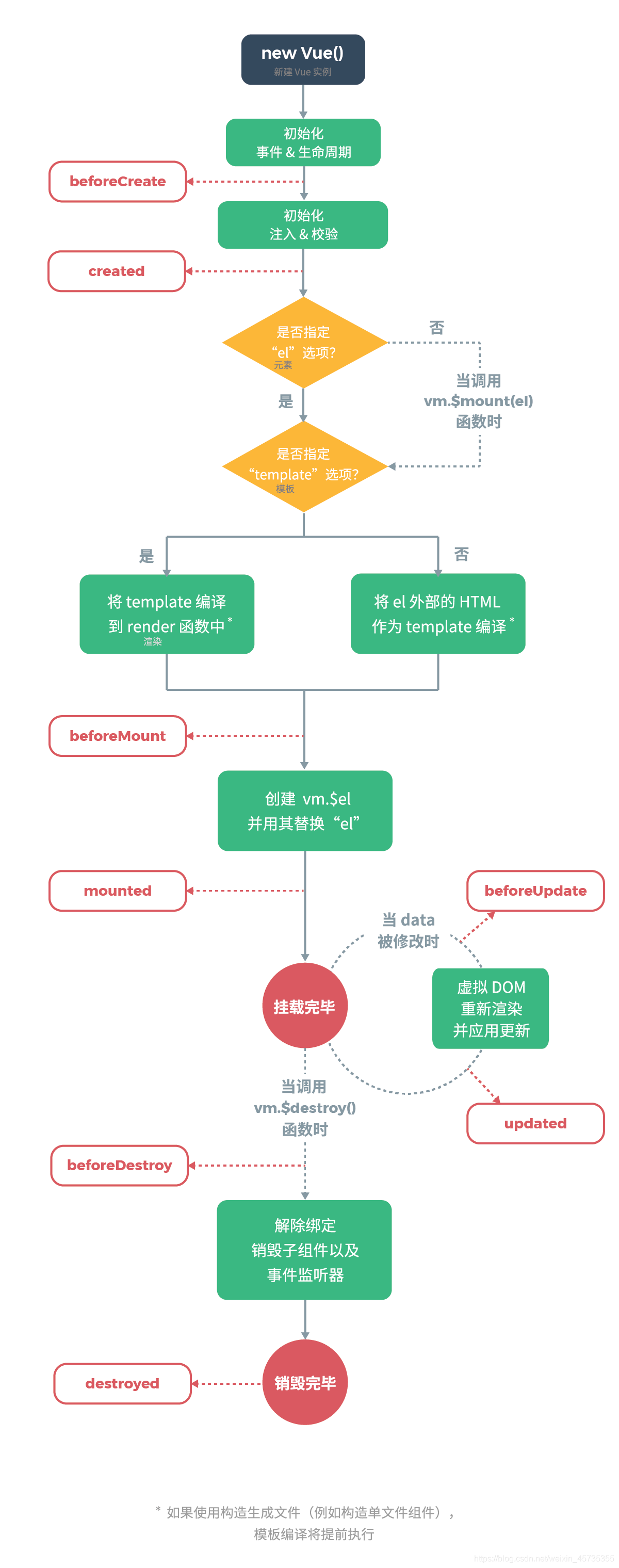
生命周期
1
2
3
4
5
6
7
8
9
10
11
12
13
14
15
16
17
18
19
20
21
22
23
24
25
26
27
28
29
30
31
32
33
34
35
36
37
38
39
40
41
42
43
44
45
46
47
48
49
50
51
52
53
| <template>
<div id="app">
<input type="button" value="修改msg" @click="msg='No'">
<h3 id="h3">
{{msg}}
</h3>
</div>
</template>
<script>
// 创建 Vue 实例,得到 ViewModel
var vm = new Vue({
el: '#app',
data: {
msg: 'ok'
},
methods: {
show(){
console.log("执行了show方法")
}
},
beforeCreate(){ //这是我们遇到的第一个生命周期函数,表示实例完全被创建出来之前,会执行它
console.log(this.msg)
this.show()
// 注意:在 beforeCreate 生命周期函数执行的时候,data 和 methods 中 数据都还没有初始化
},
created(){ // 这是遇到的第二个生命周期函数
console.log(this.msg)
this.show()
// 在 created 中, data 和 methods 都已经初始化好了
// 如果要调用 methods 中的方法, 或者操作 data 中的数库, 最早,只能在 created
},
beforeMount(){ // 这是遇到的第3个生命周期函数,表示 模板已经在内存中编辑完成了,但是尚未把模板渲染到页面中
console.log(document.getElementById('h3').innerText)
// 在 beforeMount 执行的时候,页面中的元素,还没有被真正替换过来,只是之前写的一些模板字符串
},
mounted(){ // 这是遇到的第4个生命周期函数,表示,内存中的模板,已经真实的挂载到了页面中,用户已经可以看到渲染好的页面
console.log(document.getElementById('h3').innerText)
// 注意:mounted 是 实例创建期间的最后一个生命周期函数,当执行完 mounted 就表示,实例已经被完全创建好了,此时,如果没有其他操作的话,这个实例,就静静的躺在内存中,一动不动(组件已经脱离了创建阶段,进入到运行阶段)
// 如果要通过某些插件操作页面上的DOM节点,最早要在 mounted 中进行
},
// 接下来是运行中的两个事件
beforeUpdate(){ // 这时候,表示 我们的界面还没有被更新(数据更新了)
console.log('界面上元素的内容:' + document.getElementById('h3').innerText) // ok
console.log('data 中的 msg 数据是:' + this.msg) // No
// 得出结论: 当执行 beforeUpdate 的时候,页面中的显示的数据,还是旧的,此时 data 数据是最新的,页面尚未和最新的数据保持同步
}
})
</script>
|
插值表达式
1
2
3
4
5
6
7
8
9
10
11
12
13
| <script type="text/javascript">
//创建vue对象
var app = new Vue({
//让vue接管div标签
el:"#app", // 这里的app就是要管理组件的id
//定义数据,里边包含一个属性name,值为"白大锅"
data:{
name:"白大锅"
}
});
</script>
<h1>欢迎来到-->{{ name }}</h1>
|
显示数据
v-text和v-html专门用来展示数据, 其作用和插值表达式类似,可以避免插值闪烁问题。插值闪烁: 在数据未加载完成时,页面会显示出原始的大括号, 过一会才会展示正常数据.
1
2
| v-text:<span v-text="msg"></span> <!-- 相当于<span>{{msg}}</span> -->
v-html:<span v-html="msg"></span> <!-- 相当于<span>{{msg}}</span> -->
|
1
2
| v-text:把数据当作纯文本显示.
v-html:遇到html标签,会正常解析
|
数据双向绑定
v-model
1
2
3
4
5
6
7
8
9
10
11
12
13
14
| <body>
<div id="app">
用户名: <input type="text" v-model="username"/>
</div>
</body>
<script type="text/javascript">
var app = new Vue({
el:"#app",
data:{
//该属性值和文本框的value属性值,保持一致
username:""
}
});
|
1
2
3
4
5
6
7
8
9
10
11
12
13
14
15
16
| //复选框
<div id="app">
<input type="checkbox" value="Java" v-model="language">Java<br>
<input type="checkbox" value="Python" v-model="language">Python<br>
<input type="checkbox" value="Swift" v-model="language">Swift<br>
</div>
<script type="text/javascript">
var app = new Vue({
el:"#app",
data:{
//数组中的值,就是被选中的元素的value属性值
language:["Java","Python"]
}
});
</script>
|
数据代理
1
2
3
4
5
6
7
8
9
10
11
12
13
| <script>
// 数据代理:通过一个对象代理对另一个对象中属性的操作(读、写)
let obj1 = {x:100}
let onj2 = {y:200}
Object.defineProperty(obj2,'x',{
get(){
return obj1.x;
},
set(value){
obj1.x = value;
}
})
</script>
|
事件绑定
1
2
3
| <div>
<button style="width: 100px;height: 50px;" v-on:click="showinfo1(12)">BUTTON</button>
</div>
|
1
2
3
4
5
| methods:{
showinfo1(data) {
this.username = "点击了按钮";
}
}
|
事件修饰符
1
2
3
4
5
6
7
8
9
10
11
12
13
14
15
16
17
18
19
20
21
22
23
24
25
26
27
28
29
30
31
32
33
34
35
36
37
38
39
40
41
42
43
44
45
46
47
48
49
50
51
52
53
54
55
56
57
58
59
60
61
62
63
64
65
66
67
68
69
70
71
72
73
74
75
| <!DOCTYPE html>
<html>
<head>
<meta charset="UTF-8" />
<title>事件修饰符</title>
<script type="text/javascript" src="../js/vue.js"></script>
</head>
<body>
<div id="root">
<h2>欢迎来到{{name}}学习</h2>
<!-- 阻止默认事件 -->
<a href="http://www.atguigu.com" @click.prevent="showInfo">点我提示信息</a>
// 这里点击之后会阻止浏览器跳转至href页面
<!-- 阻止事件冒泡 -->
<div class="demo1" @click="showInfo">
<button @click.stop="showInfo">点我提示信息</button>
// 点击内部的按钮时会防止触发外部div的点击事件
</div>
<!-- 事件只触发一次 -->
<button @click.once="showInfo">点我提示信息</button>
<!-- 使用事件的捕获模式 -->
<div class="box1" @click.capture="showMsg(1)">
div1
<div class="box2" @click="showMsg(2)">
div2
// 与冒泡的顺序相反,使用事件捕获,外部组件会先一步调用
</div>
</div>
<!-- 只有event.target是当前操作的元素时才触发事件 -->
<div class="demo1" @click.self="showInfo">
<button @click="showInfo">点我提示信息</button>
// 点击button时,当没有添加self修饰符时,冒泡的触发target全为button,当我们添加self修饰符时,由于target为button,因此不会触发外部事件。与阻止冒泡类似
</div>
<!-- 事件的默认行为立即执行,无需等待事件回调执行完毕 -->
<ul @wheel.passive="demo" class="list">
<li>1</li>
<li>2</li>
<li>3</li>
<li>4</li>
</ul>
</div>
</body>
<script type="text/javascript">
Vue.config.productionTip = false
new Vue({
el:'#root',
data:{
name:'尚硅谷'
},
methods:{
showInfo(e){
alert('同学你好!')
},
showMsg(msg){
console.log(msg)
},
demo(){ // 无须等待此函数运行完成
for (let i = 0; i < 100000; i++) {
console.log('#')
}
console.log('累坏了')
}
}
})
</script>
</html>
|
- prevent:阻止默认事件(常用)
- stop:阻止事件冒泡(常用)
- once:事件只触发一次(常用)
- capture:使用事件的捕获模式
- self:只有
event.target是当前操作的元素时才触发事件
- passive:事件的默认行为立即执行,无需等待事件回调执行完毕
计算属性
1
2
3
4
5
6
7
8
9
10
11
12
| computed:{
fullName:{
get(){
return this.firstName + '-' + this.lastName
},
set(value){
const arr = value.split('-')
this.firstName = arr[0]
this.lastName = arr[1]
}
}
}
|
定义:要用的属性不存在,需要通过已有属性计算得来。
原理:底层借助了Objcet.defineproperty()方法提供的getter和setter。
get函数什么时候执行?
初次读取时会执行一次
当依赖的数据发生改变时会被再次调用
优势:与methods实现相比,内部有缓存机制(复用),效率更高,调试方便
监视属性
1
2
3
4
5
6
7
8
9
| watch:{
isHot:{
immediate:true, //初始化时让handler调用一下
//handler什么时候调用?当isHot发生改变时
handler(newValue,oldValue){
console.log('isHot被修改了',newValue,oldValue)
}
}
}
|
总结:
监视属性watch:
- 当被监视的属性变化时,回调函数自动调用,进行相关操作
- 监视的属性必须存在,才能进行监视
- 监视有两种写法:
- 创建Vue时传入watch配置
- 通过
vm.$watch监视 通常在开发时,开始不晓得需要监视,后面添加。
1
2
3
4
5
6
| vm.$watch('isHot',{
immediate:true,
handler(newValue,oldValue){
console.log('isHot被修改了',newValue,oldValue)
}
})
|
深度监视
<script>
Vue.config.productionTip = false
new Vue({
el:'#root',
data:{
isHot:true,
numbers:{
a:1,
b:1,
}
},
watch:{
//监视多级结构中所有属性的变化
numbers:{
deep:true,
handler(){
console.log('numbers改变了')
}
}
//监视多级结构中某个属性的变化
/* 'numbers.a':{
handler(){
console.log('a被改变了')
}
} */
}
})
</script>
</body>
</html>
深度监视:
- Vue中的watch默认不监测对象内部值的改变(一层)
- 在watch中配置
deep:true可以监测对象内部值的改变(多层)
总结:
- computed和watch之间的区别:
- computed能完成的功能,watch都可以完成
- watch能完成的功能,computed不一定能完成,例如:watch可以进行异步操作
- 两个重要的小原则:
- 所有被Vue管理的函数,最好写成普通函数,这样this的指向才是vm 或 组件实例对象
- 所有不被Vue所管理的函数(定时器的回调函数、ajax的回调函数等、Promise的回调函数),最好写成箭头函数,这样this的指向才是vm 或 组件实例对象。
条件渲染
1
2
3
4
5
6
7
8
9
| <h2 v-show="true">Hello,{{name}}!</h2>
适用于:切换频率较高的场景
特点:不展示的DOM元素未被移除,仅仅是使用样式隐藏掉
<div v-if="n === 1">Angular</div>
<div v-else-if="n === 2">React</div>
<div v-else>Vue</div>
适用于:切换频率较低的场景
特点:不展示的DOM元素直接被移除
|
列表过滤
1
2
3
4
5
6
7
8
9
10
11
12
13
14
15
16
17
18
19
20
21
22
23
24
25
26
27
28
29
30
31
32
33
34
35
36
37
38
39
40
41
42
43
44
45
| <!DOCTYPE html>
<html>
<head>
<meta charset="UTF-8" />
<title>列表过滤</title>
<script type="text/javascript" src="../js/vue.js"></script>
</head>
<body>
<div id="root">
<h2>人员列表</h2>
<input type="text" placeholder="请输入名字" v-model="keyWord">
<ul>
<li v-for="(p,index) of filPersons" :key="index">
{{p.name}}-{{p.age}}-{{p.sex}}
</li>
</ul>
</div>
<script type="text/javascript">
Vue.config.productionTip = false
new Vue({
el:'#root',
data:{
keyWord:'',
persons:[
{id:'001',name:'马冬梅',age:19,sex:'女'},
{id:'002',name:'周冬雨',age:20,sex:'女'},
{id:'003',name:'周杰伦',age:21,sex:'男'},
{id:'004',name:'温兆伦',age:22,sex:'男'}
]
},
computed:{
// 利用计算属性过滤信息
filPersons(){
return this.persons.filter((p)=>{
return p.name.indexOf(this.keyWord) !== -1
})
}
}
})
</script>
</body>
</html>
|
总结:
Vue监视数据的原理:
vue会监视data中所有层次的数据
如何监测对象中的数据?
通过setter实现监视,且要在new Vue时就传入要监测的数据
- 对象中后追加的属性,Vue默认不做响应式处理
- 如需给后添加的属性做响应式,请使用如下API:
Vue.set(target,propertyName/index,value)vm.$set(target,propertyName/index,value)
如何监测数组中的数据?
通过包裹数组更新元素的方法实现,本质就是做了两件事:
- 调用原生对应的方法对数组进行更新
- 重新解析模板,进而更新页面
在Vue修改数组中的某个元素一定要用如下方法:
- 使用这些API:
push()、pop()、shift()、unshift()、splice()、sort()、reverse()
Vue.set() 或 vm.$set()
过滤器
1
2
3
4
5
6
7
8
9
10
11
12
13
14
15
16
17
18
19
20
21
22
23
24
25
26
27
28
29
30
31
32
33
34
35
36
37
38
39
| <!DOCTYPE html>
<html>
<head>
<meta charset="UTF-8" />
<title>过滤器</title>
<script type="text/javascript" src="../js/vue.js"></script>
<script src="https://cdn.bootcdn.net/ajax/libs/dayjs/1.10.6/dayjs.min.js"></script>
</head>
<body>
<div id="root">
<h2>时间</h2>
<h3>当前时间戳:{{time}}</h3>
<h3>转换后时间:{{time | timeFormater()}}</h3>
<h3>转换后时间:{{time | timeFormater('YYYY-MM-DD HH:mm:ss')}}</h3>
<h3>截取年月日:{{time | timeFormater() | mySlice}}</h3>
</div>
</body>
<script type="text/javascript">
Vue.config.productionTip = false
//全局过滤器,在任意的Vue对象中都可以使用
Vue.filter('mySlice',function(value){
return value.slice(0,11)
})
new Vue({
el:'#root',
data:{
time:1626750147900,
},
//局部过滤器
filters:{
timeFormater(value, str="YYYY年MM月DD日 HH:mm:ss"){
return dayjs(value).format(str)
}
}
})
</script>
</html>
|
总结:
过滤器:
- 定义:对要显示的数据进行特定格式化后再显示(适用于一些简单逻辑的处理)。
- 语法:
- 注册过滤器:
Vue.filter(name,callback) 或 new Vue{filters:{}}
- 使用过滤器:
{{ xxx | 过滤器名}} 或 v-bind:属性 = "xxx | 过滤器名"
- 备注:
- 过滤器可以接收额外参数,多个过滤器也可以串联
- 并没有改变原本的数据,而是产生新的对应的数据
自定义指令
总结:
自定义指令定义语法:
局部指令:
new Vue({
directives:{指令名:配置对象}
})
123
1
2
3
4
5
6
|
2. ```javascript
new Vue({
directives:{指令名:回调函数}
})
123
|
全局指令:
Vue.directive(指令名,配置对象)Vue.directive(指令名,回调函数)
例如:
1
2
3
4
5
6
7
8
9
10
11
12
13
14
15
| Vue.directive('fbind',{
bind(element,binding){
element.value = binding.value
},
inserted(element,binding){
element.focus()
},
update(element,binding){
element.value = binding.value
}
})
1234567891011121314
|
配置对象中常用的3个回调函数:
bind(element,binding):指令与元素成功绑定时调用inserted(element,binding):指令所在元素被插入页面时调用update(element,binding):指令所在模板结构被重新解析时调用
备注:
指令定义时不加“v-”,但使用时要加“v-”
指令名如果是多个单词,要使用kebab-case命名方式,不要用camelCase命名
1
2
3
4
5
6
7
8
9
10
11
| new Vue({
el:'#root',
data:{
n:1
},
directives:{
'big-number'(element,binding){
element.innerText = binding.value * 10
}
}
})
|
生命周期
- 又名:生命周期回调函数、生命周期函数、生命周期钩子
- 是什么:Vue在关键时刻帮我们调用的一些特殊名称的函数
- 生命周期函数的名字不可更改,但函数的具体内容是程序员根据需求编写的
- 生命周期函数中的this指向是vm 或 组件实例对象
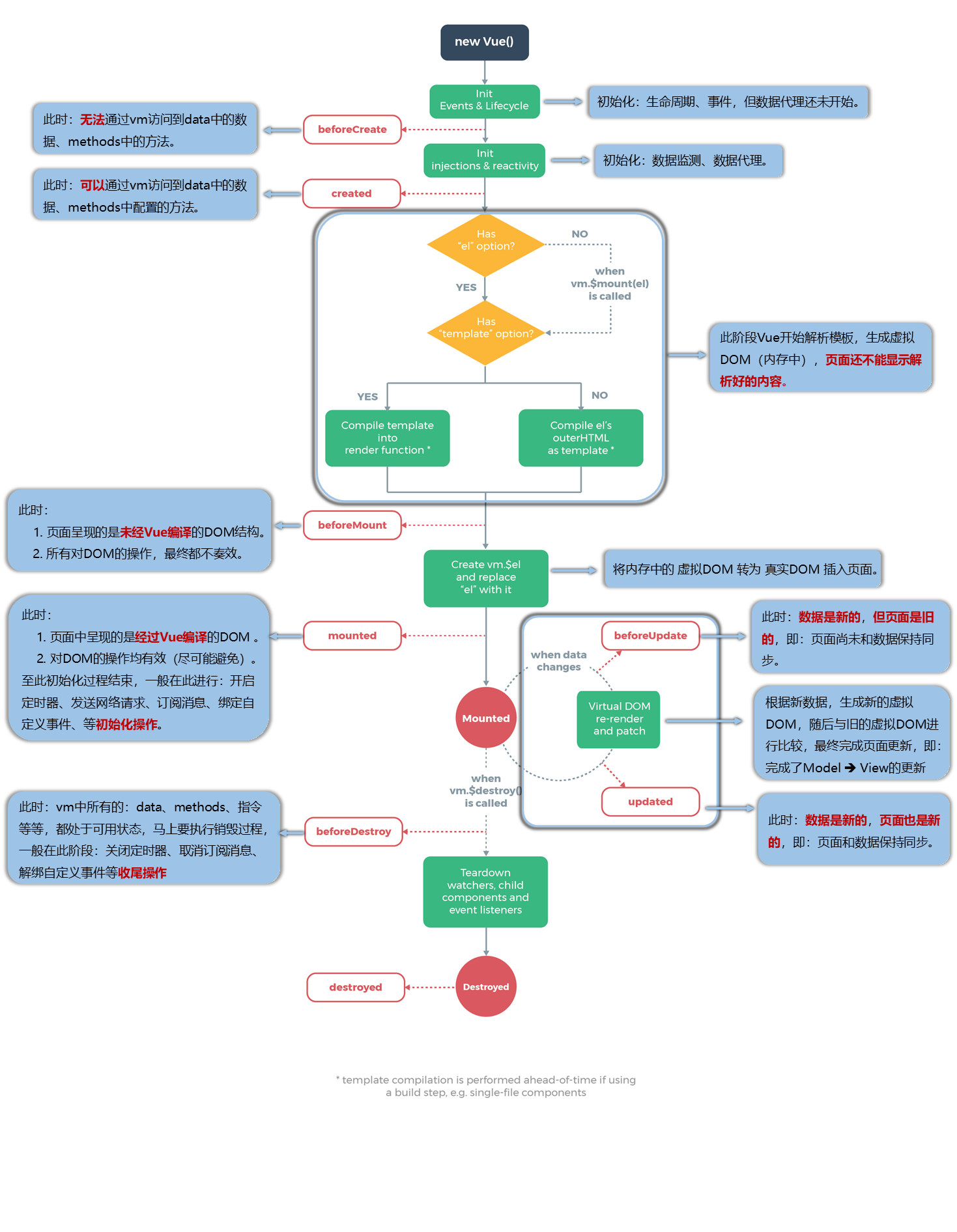
Vue组件化编程
模块与组件、模块化与组件化
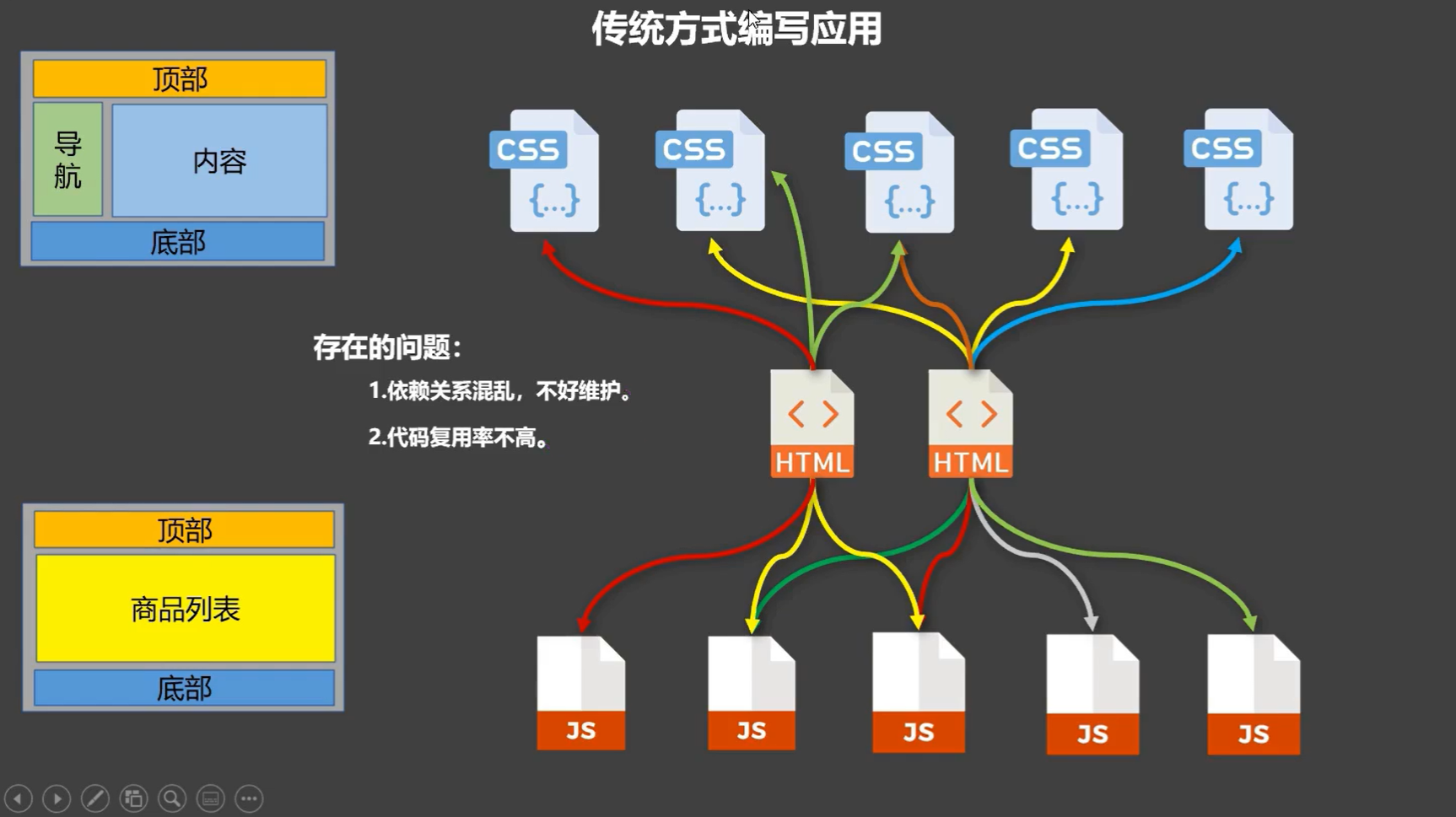
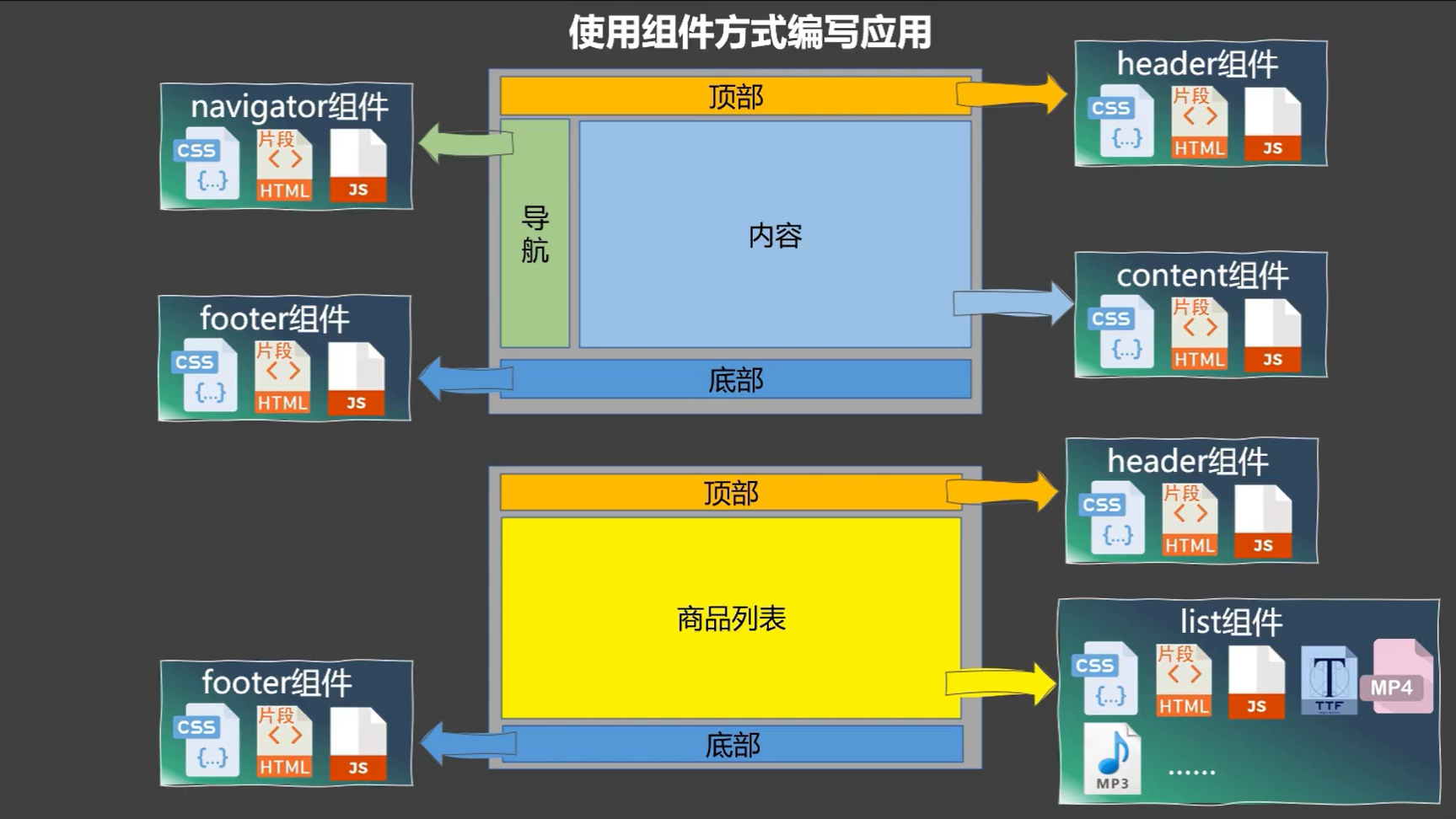
模块
- 理解:向外提供特定功能的 js 程序,一般就是一个 js 文件
- 为什么:js 文件很多很复杂
- 作用:复用 js,简化 js 的编写,提高 js 运行效率
组件
- 定义:用来实现局部功能的代码和资源的集合(html/css/js/image…)
- 为什么:一个界面的功能很复杂
- 作用:复用编码,简化项目编码,提高运行效率
模块化
当应用中的 js 都以模块来编写的,那这个应用就是一个模块化的应用
组件化
当应用中的功能都是多组件的方式来编写的,那这个应用就是一个组件化的应用
非单文件组件
基本使用
1
2
3
4
5
6
7
8
9
10
11
12
13
14
15
16
17
18
19
20
21
22
23
24
25
26
27
28
29
30
31
32
33
34
35
36
37
38
39
40
41
42
43
44
45
46
47
48
49
50
51
52
53
54
55
56
57
58
59
60
61
62
63
64
65
66
67
68
69
70
| <!DOCTYPE html>
<html>
<head>
<meta charset="UTF-8" />
<title>基本使用</title>
<script type="text/javascript" src="../js/vue.js"></script>
</head>
<body>
<div id="root">
<h1>{{msg}}</h1>
<hr>
<school></school>
<hr>
<student></student>
</div>
</body>
<script type="text/javascript">
Vue.config.productionTip = false
//第一步:创建school组件
const school = Vue.extend({
//组件定义时,一定不要写el配置项,因为最终所有的组件都要被一个vm管理,由vm决定服务于哪个容器。
template:`
<div class="demo">
<h2>学校名称:{{schoolName}}</h2>
<h2>学校地址:{{address}}</h2>
</div>
`,
data(){
return {
schoolName:'尚硅谷',
address:'北京昌平'
}
}
})
//第一步:创建student组件
const student = Vue.extend({
template:`
<div>
<h2>学生姓名:{{studentName}}</h2>
<h2>学生年龄:{{age}}</h2>
</div>
`,
data(){
return {
studentName:'JOJO',
age:20
}
}
})
//创建vm
new Vue({
el:'#root',
data:{
msg:'你好,JOJO!'
},
//第二步:注册组件(局部注册)
components:{
school,
student
}
})
</script>
</html>
|
总结:
Vue中使用组件的三大步骤:
- 定义组件(创建组件)
- 注册组件
- 使用组件(写组件标签)
如何定义一个组件?
使用Vue.extend(options)创建,其中options和new Vue(options)时传入的options几乎一样,但也有点区别:
el不要写,为什么?
最终所有的组件都要经过一个vm的管理,由vm中的el决定服务哪个容器
data必须写成函数,为什么?
避免组件被复用时,数据存在引用关系
如何注册组件?
- 局部注册:
new Vue的时候传入components选项
- 全局注册:
Vue.component('组件名',组件)
注意:创建自定义组件无论是否用到了Vue实例,都必须要有Vue实例,并且只能在Vue实例绑定的标签内才能使用自定义组件!!!
组件与Vue的内置关系
1
2
3
4
5
6
7
8
9
10
11
12
13
14
15
16
17
18
19
20
21
22
23
24
25
26
27
28
29
30
31
32
33
34
35
36
37
38
39
40
41
42
43
44
45
46
47
48
49
| <!DOCTYPE html>
<html>
<head>
<meta charset="UTF-8" />
<title>一个重要的内置关系</title>
<script type="text/javascript" src="../js/vue.js"></script>
</head>
<body>
<div id="root">
<school></school>
</div>
</body>
<script type="text/javascript">
Vue.config.productionTip = false
Vue.prototype.x = 99
const school = Vue.extend({
name:'school',
template:`
<div>
<h2>学校名称:{{name}}</h2>
<h2>学校地址:{{address}}</h2>
<button @click="showX">点我输出x</button>
</div>
`,
data(){
return {
name:'尚硅谷',
address:'北京'
}
},
methods: {
showX(){
console.log(this.x)
}
},
})
const vm = new Vue({
el:'#root',
data:{
msg:'你好'
},
components:{school}
})
</script>
</html>
|
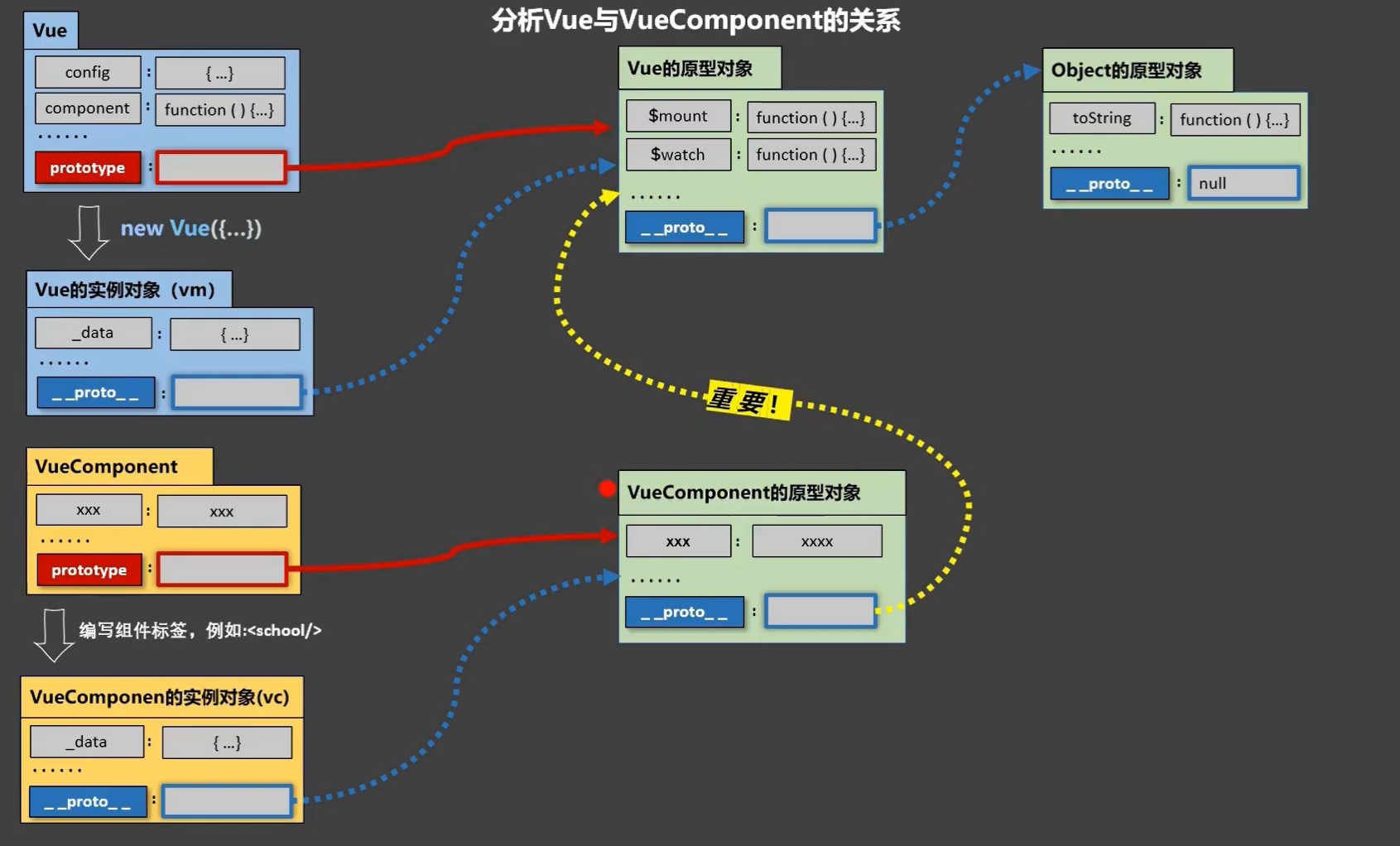
- 一个重要的内置关系:
VueComponent.prototype.__proto__ === Vue.prototype
- 为什么要有这个关系:让组件实例对象(vc)可以访问到 Vue 原型上的属性、方法
使用Vue CLI脚手架
具体步骤
- 如果下载缓慢请配置 npm 淘宝镜像:
npm config set registry http://registry.npm.taobao.org
- 全局安装@vue/cli:
npm install -g @vue/cli
- 切换到你要创建项目的目录,然后使用命令创建项目:
vue create xxxx
- 选择使用vue的版本
- 启动项目:
npm run serve
- 暂停项目:Ctrl+C
Vue 脚手架隐藏了所有 webpack 相关的配置,若想查看具体的 webpakc 配置,请执行:
ref属性
与html的id类似
1
2
3
4
5
6
7
8
9
10
11
12
13
14
15
16
17
18
19
20
21
22
23
24
25
26
27
28
| <template>
<div>
<h1 ref="title">{{msg}}</h1>
<School ref="sch"/>
<button @click="show" ref="btn">点我输出ref</button>
</div>
</template>
<script>
import School from './components/School.vue'
export default {
name:'App',
components: { School },
data() {
return {
msg:'欢迎学习Vue!'
}
},
methods:{
show(){
console.log(this.$refs.title)
console.log(this.$refs.sch)
console.log(this.$refs.btn)
}
}
}
</script>
|
总结:
ref属性:
- 被用来给元素或子组件注册引用信息(id的替代者)
- 应用在
html标签上获取的是真实DOM元素,应用在组件标签上获取的是组件实例对象(vc)
- 使用方式:
- 打标识:
<h1 ref="xxx"></h1> 或 <School ref="xxx"></School>
- 获取:
this.$refs.xxx
props配置项
1
2
3
4
5
6
7
8
9
10
11
12
13
14
| <template>
<div>
<Student name="JOJO" sex="男酮" :age="20" /> <--数值类型或函数类型的参数最好使用`:`-->
</div>
</template>
<script>
import Student from './components/Student.vue'
export default {
name:'App',
components: { Student },
}
</script>
|
1
2
3
4
5
6
7
8
9
10
11
12
13
14
15
16
17
18
19
20
21
22
23
24
25
26
27
28
29
30
31
32
33
34
35
36
37
38
39
40
41
42
43
44
45
| <template>
<div>
<h1>{{msg}}</h1>
<h2>学生姓名:{{name}}</h2>
<h2>学生性别:{{sex}}</h2>
<h2>学生年龄:{{age}}</h2>
</div>
</template>
<script>
export default {
name:'Student',
data() {
return {
msg:"我是一名来自枝江大学的男酮,嘿嘿,我的金轮~~",
}
},
// 简单声明接收
// props:['name','age','sex']
// 接收的同时对数据进行类型限制
/* props:{
name:String,
age:Number,
sex:String
} */
// 接收的同时对数据进行类型限制 + 指定默认值 + 限制必要性
props:{
name:{
type:String,
required:true,
},
age:{
type:Number,
default:99
},
sex:{
type:String,
required:true
}
}
}
</script>
|
总结:
props配置项:
功能:让组件接收外部传过来的数据
传递数据:<Demo name="xxx"/>
接收数据:
第一种方式(只接收):props:['name']
第二种方式(限制数据类型):props:{name:String}
第三种方式(限制类型、限制必要性、指定默认值):
1
2
3
4
5
6
7
| props:{
name:{
type:String,
required:true,
default:'JOJO'
}
}
|
props是只读的,Vue底层会监测你对props的修改,如果进行了修改,就会发出警告,若业务需求确实需要修改,那么请复制props的内容到data中一份,然后去修改data中的数据
mixin混入
局部混入
src/mixin.js:
1
2
3
4
5
6
7
8
9
10
11
12
13
14
15
16
17
18
19
20
21
22
23
24
25
26
27
28
29
30
31
32
33
34
35
| export const mixin = {
methods: {
showName() {
alert(this.name)
}
},
mounted() {
console.log("你好呀~")
}
}
12345678910
src/components/School.vue
<template>
<div>
<h2 @click="showName">学校姓名:{{name}}</h2>
<h2>学校地址:{{address}}</h2>
</div>
</template>
<script>
import {mixin} from '../mixin'
export default {
name:'School',
data() {
return {
name:'尚硅谷',
address:'北京'
}
},
mixins:[mixin]
}
</script>
12345678910111213141516171819202122
|
src/components/Student.vue:
1
2
3
4
5
6
7
8
9
10
11
12
13
14
15
16
17
18
19
20
21
22
23
| <template>
<div>
<h2 @click="showName">学生姓名:{{name}}</h2>
<h2>学生性别:{{sex}}</h2>
</div>
</template>
<script>
//引入混入
import {mixin} from '../mixin'
export default {
name:'Student',
data() {
return {
name:'JOJO',
sex:'男'
}
},
mixins:[mixin]
}
</script>
12345678910111213141516171819202122
|
src/App.vue:
1
2
3
4
5
6
7
8
9
10
11
12
13
14
15
16
17
| <template>
<div>
<School/>
<hr/>
<Student/>
</div>
</template>
<script>
import Student from './components/Student.vue'
import School from './components/School.vue'
export default {
name:'App',
components: { Student,School },
}
</script>
|
全局混入:
src/main.js:
1
2
3
4
5
6
7
8
9
10
11
| import Vue from 'vue'
import App from './App.vue'
import {mixin} from './mixin'
Vue.config.productionTip = false
Vue.mixin(mixin)
new Vue({
el:"#app",
render: h => h(App)
})
|
plugin插件
src/plugin.js:
1
2
3
4
5
6
7
8
9
10
11
12
13
14
15
16
17
18
19
20
21
22
23
| export default {
install(Vue,x,y,z){
console.log(x,y,z)
Vue.filter('mySlice',function(value){
return value.slice(0,4)
})
Vue.mixin({
data() {
return {
x:100,
y:200
}
},
})
Vue.prototype.hello = ()=>{alert('你好啊')}
}
}
|
src/main.js:
1
2
3
4
5
6
7
8
9
10
11
12
13
| import Vue from 'vue'
import App from './App.vue'
import plugin from './plugin'
Vue.config.productionTip = false
Vue.use(plugin,1,2,3)
new Vue({
el:"#app",
render: h => h(App)
})
|
src/components/School.vue:
1
2
3
4
5
6
7
8
9
10
11
12
13
14
15
16
17
18
19
| <template>
<div>
<h2>学校姓名:{{name | mySlice}}</h2>
<h2>学校地址:{{address}}</h2>
</div>
</template>
<script>
export default {
name:'School',
data() {
return {
name:'尚硅谷atguigu',
address:'北京'
}
}
}
</script>
123456789101112131415161718
|
src/components/Student.vue:
1
2
3
4
5
6
7
8
9
10
11
12
13
14
15
16
17
18
19
20
21
22
23
24
| <template>
<div>
<h2>学生姓名:{{name}}</h2>
<h2>学生性别:{{sex}}</h2>
<button @click="test">点我测试hello方法</button>
</div>
</template>
<script>
export default {
name:'Student',
data() {
return {
name:'JOJO',
sex:'男'
}
},
methods:{
test() {
this.hello()
}
}
}
</script>
|
总结:
插件:
功能:用于增强Vue
本质:包含install方法的一个对象,install的第一个参数是Vue,第二个以后的参数是插件使用者传递的数据
定义插件:
1
2
3
4
5
6
7
8
9
10
11
12
13
14
15
| plugin.install = function (Vue, options) {
Vue.filter(....)
Vue.directive(....)
Vue.mixin(....)
Vue.prototype.$myMethod = function () {...}
Vue.prototype.$myProperty = xxxx
}
|
使用插件:Vue.use(plugin)
Scoped样式
1
2
3
4
5
| <style scoped>
.demo{
background-color: chartreuse;
}
</style>
|
总结:
scoped样式:
- 作用:让样式在局部生效,防止冲突
- 写法:
<style scoped>
scoped样式一般不会在App.vue中使用
WebStorage
1
2
3
4
5
6
7
8
9
10
11
12
13
14
15
16
17
18
19
20
21
22
23
24
25
26
27
28
29
30
31
32
33
34
35
36
37
38
| <!DOCTYPE html>
<html lang="en">
<head>
<meta charset="UTF-8">
<meta http-equiv="X-UA-Compatible" content="IE=edge">
<meta name="viewport" content="width=device-width, initial-scale=1.0">
<title>localStorage</title>
</head>
<body>
<h2>localStorage</h2>
<button onclick="saveDate()">点我保存数据</button><br/>
<button onclick="readDate()">点我读数据</button><br/>
<button onclick="deleteDate()">点我删除数据</button><br/>
<button onclick="deleteAllDate()">点我清空数据</button><br/>
<script>
let person = {name:"JOJO",age:20}
function saveDate(){
localStorage.setItem('msg','localStorage')
localStorage.setItem('person',JSON.stringify(person))
}
function readDate(){
console.log(localStorage.getItem('msg'))
const person = localStorage.getItem('person')
console.log(JSON.parse(person))
}
function deleteDate(){
localStorage.removeItem('msg')
localStorage.removeItem('person')
}
function deleteAllDate(){
localStorage.clear()
}
</script>
</body>
</html>
|
1
2
3
4
5
6
7
8
9
10
11
12
13
14
15
16
17
18
19
20
21
22
23
24
25
26
27
28
29
30
31
32
33
34
35
36
37
38
| <!DOCTYPE html>
<html lang="en">
<head>
<meta charset="UTF-8">
<meta http-equiv="X-UA-Compatible" content="IE=edge">
<meta name="viewport" content="width=device-width, initial-scale=1.0">
<title>sessionStorage</title>
</head>
<body>
<h2>sessionStorage</h2>
<button onclick="saveDate()">点我保存数据</button><br/>
<button onclick="readDate()">点我读数据</button><br/>
<button onclick="deleteDate()">点我删除数据</button><br/>
<button onclick="deleteAllDate()">点我清空数据</button><br/>
<script>
let person = {name:"JOJO",age:20}
function saveDate(){
sessionStorage.setItem('msg','sessionStorage')
sessionStorage.setItem('person',JSON.stringify(person))
}
function readDate(){
console.log(sessionStorage.getItem('msg'))
const person = sessionStorage.getItem('person')
console.log(JSON.parse(person))
}
function deleteDate(){
sessionStorage.removeItem('msg')
sessionStorage.removeItem('person')
}
function deleteAllDate(){
sessionStorage.clear()
}
</script>
</body>
</html>
|
总结:
- 存储内容大小一般支持5MB左右(不同浏览器可能还不一样)
- 浏览器端通过
Window.sessionStorage和Window.localStorage属性来实现本地存储机制
- 相关API:
xxxStorage.setItem('key', 'value'):该方法接受一个键和值作为参数,会把键值对添加到存储中,如果键名存在,则更新其对应的值xxxStorage.getItem('key'):该方法接受一个键名作为参数,返回键名对应的值xxxStorage.removeItem('key'):该方法接受一个键名作为参数,并把该键名从存储中删除xxxStorage.clear():该方法会清空存储中的所有数据
- 备注:
SessionStorage存储的内容会随着浏览器窗口关闭而消失LocalStorage存储的内容,需要手动清除才会消失xxxStorage.getItem(xxx)如果 xxx 对应的 value 获取不到,那么getItem()的返回值是nullJSON.parse(null)的结果依然是null
组件的自定义事件
绑定
src/App.vue:
1
2
3
4
5
6
7
8
9
10
11
12
13
14
15
16
17
18
19
20
21
22
23
24
25
26
27
28
29
30
31
32
33
34
35
36
37
38
39
40
41
42
| <template>
<div class="app">
<!-- 通过父组件给子组件传递函数类型的props实现父给子传递数据 -->
<School :getSchoolName="getSchoolName"/> // :为单向数据绑定
<!-- 通过父组件给子组件绑定一个自定义事件实现子给父传递数据(第一种写法,使用@或v-on) -->
<!-- <Student @jojo="getStudentName"/> --> <!--这里给Student组件绑定了一个自定义的jojo事件。-->
<!-- 通过父组件给子组件绑定一个自定义事件实现子给父传递数据(第二种写法,使用ref) -->
<Student ref="student"/> <!--这里相当于给Student组件添加了一个id-->
</div>
</template>
<script>
import Student from './components/Student.vue'
import School from './components/School.vue'
export default {
name:'App',
components: { Student,School },
methods:{
getSchoolName(name){
console.log("已收到学校的名称:"+name)
},
getStudentName(name){
console.log("已收到学生的姓名:"+name)
}
},
mounted(){
<!--使用这种方式绑定自定义事件更加的灵活-->
this.$refs.student.$on('jojo',this.getStudentName)
}
}
</script>
<style scoped>
.app{
background-color: gray;
padding: 5px;
}
</style>
|
src/components/Student.vue:
1
2
3
4
5
6
7
8
9
10
11
12
13
14
15
16
17
18
19
20
21
22
23
24
25
26
27
28
29
30
31
32
33
| <template>
<div class="student">
<h2>学生姓名:{{name}}</h2>
<h2>学生性别:{{sex}}</h2>
<button @click="sendStudentName">点我传递学生姓名</button>
</div>
</template>
<script>
export default {
name:'Student',
data() {
return {
name:'JOJO',
sex:'男'
}
},
methods:{
sendStudentName(){
<!--触发jojo事件-->
this.$emit('jojo',this.name)
}
}
}
</script>
<style scoped>
.student{
background-color: chartreuse;
padding: 5px;
margin-top: 30px;
}
</style>
|
效果:
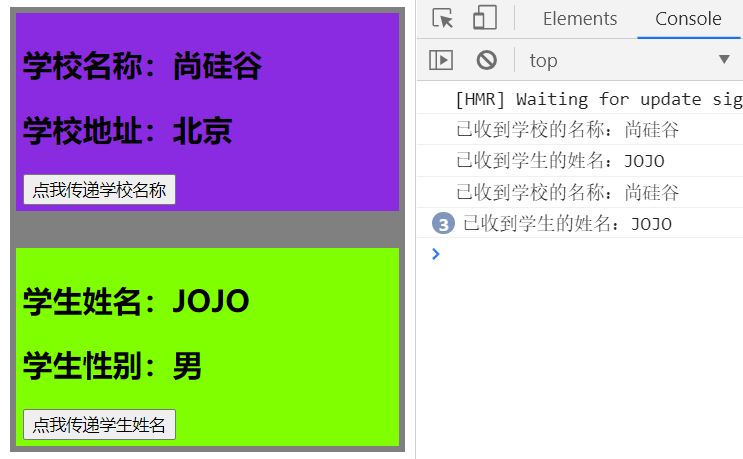
解绑
src/App.vue:
1
2
3
4
5
6
7
8
9
10
11
12
13
14
15
16
17
18
19
20
21
22
23
24
25
26
| <template>
<div class="app">
<Student @jojo="getStudentName"/>
</div>
</template>
<script>
import Student from './components/Student.vue'
export default {
name:'App',
components: { Student },
methods:{
getStudentName(name){
console.log("已收到学生的姓名:"+name)
}
}
}
</script>
<style scoped>
.app{
background-color: gray;
padding: 5px;
}
</style>
|
src/components/Student.vue:
1
2
3
4
5
6
7
8
9
10
11
12
13
14
15
16
17
18
19
20
21
22
23
24
25
26
27
28
29
30
31
32
33
34
35
36
37
38
39
40
41
42
| <template>
<div class="student">
<h2>学生姓名:{{name}}</h2>
<h2>学生性别:{{sex}}</h2>
<button @click="sendStudentName">点我传递学生姓名</button>
<button @click="unbind">解绑自定义事件</button>
</div>
</template>
<script>
export default {
name:'Student',
data() {
return {
name:'JOJO',
sex:'男'
}
},
methods:{
sendStudentName(){
this.$emit('jojo',this.name)
},
unbind(){
// 解绑一个自定义事件
// this.$off('jojo')
// 解绑多个自定义事件
// this.$off(['jojo'])
// 解绑所有自定义事件
this.$off()
}
}
}
</script>
<style scoped>
.student{
background-color: chartreuse;
padding: 5px;
margin-top: 30px;
}
</style>
|
效果:
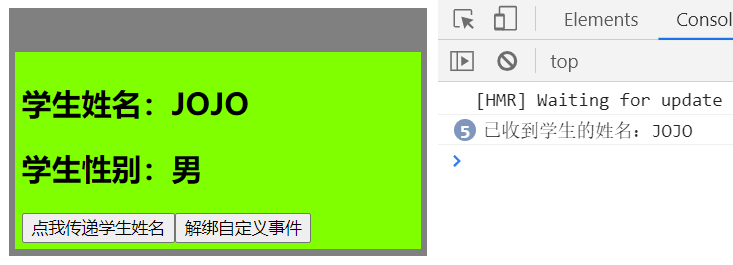
总结:
组件的自定义事件:
一种组件间通信的方式,适用于:==子组件 > 父组件
使用场景:A是父组件,B是子组件,B想给A传数据,那么就要在A中给B绑定自定义事件(事件的回调在A中)
绑定自定义事件:
第一种方式,在父组件中:<Demo @atguigu="test"/> 或 <Demo v-on:atguigu="test"/>
第二种方式,在父组件中:
1
2
3
4
5
| <Demo ref="demo"/>
...
mounted(){
this.$refs.demo.$on('atguigu',data)
}
|
若想让自定义事件只能触发一次,可以使用once修饰符,或$once方法
触发自定义事件:this.$emit('atguigu',数据)
解绑自定义事件:this.$off('atguigu')
组件上也可以绑定原生DOM事件,需要使用native修饰符
注意:通过this.$refs.xxx.$on('atguigu',回调)绑定自定义事件时,回调要么配置在methods中,要么用箭头函数,否则this指向会出问题!
全局事件总线
全局事件总线(GlobalEventBus):
一种组件间通信的方式,适用于任意组件间通信
安装全局事件总线:
1
2
3
4
5
6
7
8
| new Vue({
...
beforeCreate() {
Vue.prototype.$bus = this
},
...
})
|
使用事件总线:
接收数据:A组件想接收数据,则在A组件中给$bus绑定自定义事件,事件的回调留在A组件自身
1
2
3
4
5
6
7
8
9
10
| export default {
methods(){
demo(data){...}
}
...
mounted() {
this.$bus.$on('xxx',this.demo)
}
}
|
提供数据:this.$bus.$emit('xxx',data)
最好在beforeDestroy钩子中,用$off去解绑当前组件所用到的事件
消息的订阅与发布
与全局事件总线类似都可以实现任意组件间的通行。
src/components/School.vue:
1
2
3
4
5
6
7
8
9
10
11
12
13
14
15
16
17
18
19
20
21
22
23
24
25
26
27
28
29
30
31
32
33
34
35
36
37
38
39
| <template>
<div class="school">
<h2>学校名称:{{name}}</h2>
<h2>学校地址:{{address}}</h2>
</div>
</template>
<script>
import pubsub from 'pubsub-js' // 引入消息队列的库
export default {
name:'School',
data() {
return {
name:'尚硅谷',
address:'北京',
}
},
methods:{
demo(msgName,data) {
console.log('我是School组件,收到了数据:',data)
}
},
mounted() {
this.pubId = pubsub.subscribe('demo',this.demo) //订阅消息
},
beforeDestroy() {
pubsub.unsubscribe(this.pubId) //取消订阅
}
}
</script>
<style scoped>
.school{
background-color: skyblue;
padding: 5px;
}
</style>
|
src/components/Student.vue:
1
2
3
4
5
6
7
8
9
10
11
12
13
14
15
16
17
18
19
20
21
22
23
24
25
26
27
28
29
30
31
32
33
34
| <template>
<div class="student">
<h2>学生姓名:{{name}}</h2>
<h2>学生性别:{{sex}}</h2>
<button @click="sendStudentName">把学生名给School组件</button>
</div>
</template>
<script>
import pubsub from 'pubsub-js'
export default {
name:'Student',
data() {
return {
name:'JOJO',
sex:'男',
}
},
methods: {
sendStudentName(){
pubsub.publish('demo',this.name) //发布消息
}
}
}
</script>
<style scoped>
.student{
background-color: pink;
padding: 5px;
margin-top: 30px;
}
</style>
|
总结:
消息订阅与发布(pubsub):
消息订阅与发布是一种组件间通信的方式,适用于任意组件间通信
使用步骤:
安装pubsub:npm i pubsub-js
引入:import pubsub from 'pubsub-js'
接收数据:A组件想接收数据,则在A组件中订阅消息,订阅的回调留在A组件自身
1
2
3
4
5
6
7
8
9
10
| export default {
methods(){
demo(data){...}
}
...
mounted() {
this.pid = pubsub.subscribe('xxx',this.demo)
}
}
123456789
|
提供数据:pubsub.publish('xxx',data)
最好在beforeDestroy钩子中,使用pubsub.unsubscribe(pid)取消订阅
$nextTick
$nextTick(回调函数)可以将回调延迟到下次DOM更新循环之后执行
通常调用函数去更新界面信息时,模板的重新解析会在函数的全部执行完成之后。
1
2
3
4
5
6
7
8
9
10
11
12
13
14
| handleEdit(todo){
// 如果todo自身有isEdit属性就将isEdit改成true
if(Object.prototype.hasOwnProperty.call(todo,'isEdit')){
todo.isEdit = true
}else{
// 如果没有就向todo中添加一个响应式的isEdit属性并设为true
this.$set(todo,'isEdit',true)
}
// 当Vue重新编译模板之后执行$nextTick()中的回调函数
this.$nextTick(function(){
// 使input框获取焦点
this.$refs.inputTitle.focus()
})
},
|
Vue中的Ajax
vue脚手架配置代理
下载axios库: npm install axios
解决跨域问题
cors 后端解决
jsonp 前后端一同解决,一般很少用到,且只能解决get跨域问题
代理服务器 使用最多
使用vue-cli
vue.config.js:
1
2
3
4
5
6
7
8
9
10
11
12
13
14
15
16
17
18
19
20
21
22
23
24
25
26
27
28
29
30
31
32
33
34
| module.exports = {
pages: {
index: {
entry: 'src/main.js',
},
},
lintOnSave:false,
devServer: {
proxy: {
'/jojo': {
target: 'http://localhost:5000',
pathRewrite:{'^/jojo':''},
},
'/atguigu': {
target: 'http://localhost:5001',
pathRewrite:{'^/atguigu':''},
}
}
}
}
|
src/App.vue:
1
2
3
4
5
6
7
8
9
10
11
12
13
14
15
16
17
18
19
20
21
22
23
24
25
26
27
28
29
30
31
32
33
34
35
36
37
| <template>
<div id="root">
<button @click="getStudents">获取学生信息</button><br/>
<button @click="getCars">获取汽车信息</button>
</div>
</template>
<script>
import axios from 'axios'
export default {
name:'App',
methods: {
getStudents(){
// 发送请求,通过代理服务器进行转发
axios.get('http://localhost:8080/jojo/students').then(
response => {
console.log('请求成功了',response.data)
},
error => {
console.log('请求失败了',error.message)
}
)
},
getCars(){
axios.get('http://localhost:8080/atguigu/cars').then(
response => {
console.log('请求成功了',response.data)
},
error => {
console.log('请求失败了',error.message)
}
)
}
}
}
</script>
|
vue-resource
下载 vue-resource库:npm i vue-resource
在Vue2中已不再更新,Vue官方也不
slot插槽
默认插槽
组件标签中间的组件放置的位置。
src/App.vue:
1
2
3
4
5
6
7
8
9
10
11
12
13
14
15
16
17
18
19
20
21
22
23
24
25
26
27
28
29
30
31
32
33
34
35
36
37
38
| <template>
<div class="container">
<Category title="美食" >
<img src="https://s3.ax1x.com/2021/01/16/srJlq0.jpg" alt="">
</Category>
<Category title="游戏" >
<ul>
<li v-for="(g,index) in games" :key="index">{{g}}</li>
</ul>
</Category>
<Category title="电影">
<video controls src="http://clips.vorwaerts-gmbh.de/big_buck_bunny.mp4"></video>
</Category>
</div>
</template>
<script>
import Category from './components/Category'
export default {
name:'App',
components:{Category},
data() {
return {
games:['植物大战僵尸','红色警戒','空洞骑士','王国']
}
},
}
</script>
<style scoped>
.container{
display: flex;
justify-content: space-around;
}
</style>
|
src/components/Category.vue:
1
2
3
4
5
6
7
8
9
10
11
12
13
14
15
16
17
18
19
20
21
22
23
24
25
26
27
28
29
30
31
32
| <template>
<div class="category">
<h3>{{title}}分类</h3>
<!-- 定义一个插槽(挖个坑,等着组件的使用者进行填充) -->
<slot>我是一些默认值,当使用者没有传递具体结构时,我会出现</slot>
</div>
</template>
<script>
export default {
name:'Category',
props:['title']
}
</script>
<style scoped>
.category{
background-color: skyblue;
width: 200px;
height: 300px;
}
h3{
text-align: center;
background-color: orange;
}
video{
width: 100%;
}
img{
width: 100%;
}
</style>
|
具名插槽
为每个插槽设置名称,为组件中的每个子组件放进对应的插槽中,否则将会将所有的子组件复制相同的
src/App.vue:
1
2
3
4
5
6
7
8
9
10
11
12
13
14
15
16
17
18
19
20
21
22
23
24
25
26
27
28
29
30
31
32
33
34
35
36
37
38
39
40
41
42
43
44
45
46
47
48
49
50
51
52
53
54
| <template>
<div class="container">
<Category title="美食" >
<img slot="center" src="https://s3.ax1x.com/2021/01/16/srJlq0.jpg" alt="">
<a slot="footer" href="http://www.atguigu.com">更多美食</a>
</Category>
<Category title="游戏" >
<ul slot="center">
<li v-for="(g,index) in games" :key="index">{{g}}</li>
</ul>
<div class="foot" slot="footer">
<a href="http://www.atguigu.com">单机游戏</a>
<a href="http://www.atguigu.com">网络游戏</a>
</div>
</Category>
<Category title="电影">
<video slot="center" controls src="http://clips.vorwaerts-gmbh.de/big_buck_bunny.mp4"></video>
<template v-slot:footer>
<div class="foot">
<a href="http://www.atguigu.com">经典</a>
<a href="http://www.atguigu.com">热门</a>
<a href="http://www.atguigu.com">推荐</a>
</div>
<h4>欢迎前来观影</h4>
</template>
</Category>
</div>
</template>
<script>
import Category from './components/Category'
export default {
name:'App',
components:{Category},
data() {
return {
games:['植物大战僵尸','红色警戒','空洞骑士','王国']
}
},
}
</script>
<style>
.container,.foot{
display: flex;
justify-content: space-around;
}
h4{
text-align: center;
}
</style>
|
src/components/Category.vue:
1
2
3
4
5
6
7
8
9
10
11
12
13
14
15
16
17
18
19
20
21
22
23
24
25
26
27
28
29
30
31
32
33
| <template>
<div class="category">
<h3>{{title}}分类</h3>
<!-- 定义一个插槽(挖个坑,等着组件的使用者进行填充) -->
<slot name="center">我是一些默认值,当使用者没有传递具体结构时,我会出现1</slot>
<slot name="footer">我是一些默认值,当使用者没有传递具体结构时,我会出现2</slot>
</div>
</template>
<script>
export default {
name:'Category',
props:['title']
}
</script>
<style scoped>
.category{
background-color: skyblue;
width: 200px;
height: 300px;
}
h3{
text-align: center;
background-color: orange;
}
video{
width: 100%;
}
img{
width: 100%;
}
</style>
|
作用域插槽
相当于在子组件中传递值给父组件。
理解:数据在组件的自身,但根据数据生成的结构需要组件的使用者来决定。(games数据在Category组件中,但使用数据所遍历出来的结构由App组件决定)
具体编码:
1
2
3
4
5
6
7
8
9
10
11
12
13
14
15
16
17
18
19
20
21
22
23
24
25
26
27
28
29
30
31
32
33
34
35
| 父组件中:
<Category>
<template scope="scopeData">
<!-- 生成的是ul列表 -->
<ul>
<li v-for="g in scopeData.games" :key="g">{{g}}</li>
</ul>
</template>
</Category>
<Category>
<template slot-scope="scopeData">
<!-- 生成的是h4标题 -->
<h4 v-for="g in scopeData.games" :key="g">{{g}}</h4>
</template>
</Category>
子组件中:
<template>
<div>
<slot :games="games"></slot>
</div>
</template>
<script>
export default {
name:'Category',
props:['title'],
//数据在子组件自身
data() {
return {
games:['红色警戒','穿越火线','劲舞团','超级玛丽']
}
},
}
</script>
|
Vuex
解决多组件之间数据共享问题。
什么时候使用:
- 多组件依赖于同一状态
- 来自不同组件的行为需要变更同一转态
工作原理图
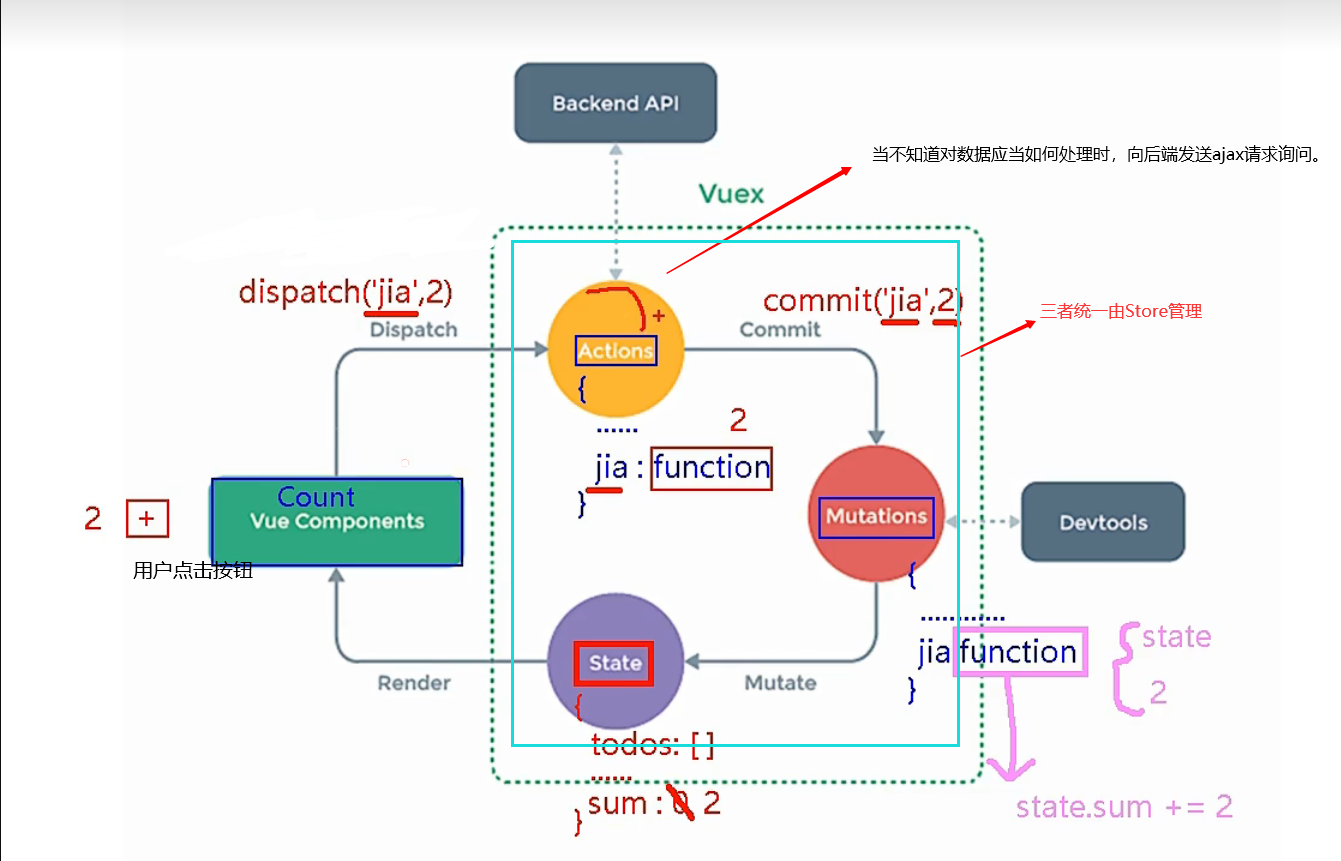
原理图解释:107_尚硅谷Vue技术_Vuex工作原理图_哔哩哔哩_bilibili
下载Vuex : npm i vuex
搭建Vuex
下载 Vuex:npm i vuex
创建src/store/index.js:
1
2
3
4
5
6
7
8
9
10
11
12
13
14
15
16
17
18
19
20
21
|
import Vue from 'vue'
import Vuex from 'vuex'
Vue.use(Vuex)
const actions = {}
const mutations = {}
const state = {}
export default new Vuex.Store({
actions,
mutations,
state
})
|
在src/main.js中创建 vm 时传入store配置项:
1
2
3
4
5
6
7
8
9
10
11
12
13
14
15
| import Vue from 'vue'
import App from './App.vue'
import Vuex from 'vuex'
import store from './store'
Vue.config.productionTip = false
Vue.use(Vuex)
new Vue({
el:"#app",
render: h => h(App),
store
})
|
使用Vuex编写
src/components/Count.vue:
1
2
3
4
5
6
7
8
9
10
11
12
13
14
15
16
17
18
19
20
21
22
23
24
25
26
27
28
29
30
31
32
33
34
35
36
37
38
39
40
41
42
43
44
45
46
| <template>
<div>
<h1>当前求和为:{{$store.state.sum}}</h1>
<select v-model.number="n">
<option value="1">1</option>
<option value="2">2</option>
<option value="3">3</option>
</select>
<button @click="increment">+</button>
<button @click="decrement">-</button>
<button @click="incrementOdd">当前求和为奇数再加</button>
<button @click="incrementWait">等一等再加</button>
</div>
</template>
<script>
export default {
name:'Count',
data() {
return {
n:1, //用户选择的数字
}
},
methods: {
increment(){
this.$store.commit('ADD',this.n)
},
decrement(){
this.$store.commit('SUBTRACT',this.n)
},
incrementOdd(){
this.$store.dispatch('addOdd',this.n)
},
incrementWait(){
this.$store.dispatch('addWait',this.n)
},
},
}
</script>
<style>
button{
margin-left: 5px;
}
</style>
|
src/store/index.js:
1
2
3
4
5
6
7
8
9
10
11
12
13
14
15
16
17
18
19
20
21
22
23
24
25
26
27
28
29
30
31
32
33
34
35
36
37
38
39
40
41
42
|
import Vue from 'vue'
import Vuex from 'vuex'
Vue.use(Vuex)
const actions = {
addOdd(context,value){
console.log("actions中的addOdd被调用了")
if(context.state.sum % 2){
context.commit('ADD',value)
}
},
addWait(context,value){
console.log("actions中的addWait被调用了")
setTimeout(()=>{
context.commit('ADD',value)
},500)
},
}
const mutations = {
ADD(state,value){
state.sum += value
},
SUBTRACT(state,value){
state.sum -= value
}
}
const state = {
sum:0
}
export default new Vuex.Store({
actions,
mutations,
state
})
|
总结:
Vuex的基本使用:
初始化数据state,配置actions、mutations,操作文件store.js
1
2
3
4
5
6
7
8
9
10
11
12
13
14
15
16
17
18
19
20
21
22
23
24
25
26
27
28
29
30
31
32
33
34
35
|
import Vue from 'vue'
import Vuex from 'vuex'
Vue.use(Vuex)
const actions = {
jia(context,value){
context.commit('JIA',value)
},
}
const mutations = {
JIA(state,value){
state.sum += value
}
}
const state = {
sum:0
}
export default new Vuex.Store({
actions,
mutations,
state,
})
|
组件中读取vuex中的数据:$store.state.sum
组件中修改vuex中的数据:$store.dispatch('action中的方法名',数据) 或 $store.commit('mutations中的方法名',数据)
备注:若没有网络请求或其他业务逻辑,组件中也可以越过actions,即不写dispatch,直接编写commit
getters
src/Count.vue:
1
2
3
4
5
6
7
8
9
10
11
12
13
14
15
16
17
18
19
20
21
22
23
24
25
26
27
28
29
30
31
32
33
34
35
36
37
38
39
40
41
42
43
44
45
46
47
| <template>
<div>
<h1>当前求和为:{{$store.state.sum}}</h1>
<h3>当前求和的10倍为:{{$store.getters.bigSum}}</h3> <!--需要对state中的数据进行加工-->
<select v-model.number="n">
<option value="1">1</option>
<option value="2">2</option>
<option value="3">3</option>
</select>
<button @click="increment">+</button>
<button @click="decrement">-</button>
<button @click="incrementOdd">当前求和为奇数再加</button>
<button @click="incrementWait">等一等再加</button>
</div>
</template>
<script>
export default {
name:'Count',
data() {
return {
n:1, //用户选择的数字
}
},
methods: {
increment(){
this.$store.commit('ADD',this.n)
},
decrement(){
this.$store.commit('SUBTRACT',this.n)
},
incrementOdd(){
this.$store.dispatch('addOdd',this.n)
},
incrementWait(){
this.$store.dispatch('addWait',this.n)
},
},
}
</script>
<style>
button{
margin-left: 5px;
}
</style>
|
src/store/index.js:
1
2
3
4
5
6
7
8
9
10
11
12
13
14
15
16
17
18
19
20
21
22
23
24
25
26
27
28
29
30
31
32
33
34
35
36
37
38
39
40
41
42
43
44
45
46
47
48
49
|
import Vue from 'vue'
import Vuex from 'vuex'
Vue.use(Vuex)
const actions = {
addOdd(context,value){
console.log("actions中的addOdd被调用了")
if(context.state.sum % 2){
context.commit('ADD',value)
}
},
addWait(context,value){
console.log("actions中的addWait被调用了")
setTimeout(()=>{
context.commit('ADD',value)
},500)
},
}
const mutations = {
ADD(state,value){
state.sum += value
},
SUBTRACT(state,value){
state.sum -= value
}
}
const state = {
sum:0
}
const getters = {
bigSum(){
return state.sum * 10
}
}
export default new Vuex.Store({
actions,
mutations,
state,
getters
})
|
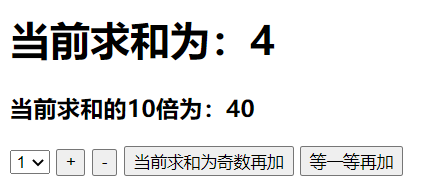
总结:
getters配置项的使用:
概念:当state中的数据需要经过加工后再使用时,可以使用getters加工
在store.js中追加getters配置
1
2
3
4
5
6
7
8
9
10
11
12
13
| ...
const getters = {
bigSum(state){
return state.sum * 10
}
}
export default new Vuex.Store({
...
getters
})
123456789101112
|
组件中读取数据:$store.getters.bigSum
四个map方法的使用
mapState与mapGetters
src/store/index.js:
1
2
3
4
5
6
7
8
9
10
11
12
13
14
15
16
17
18
19
20
21
22
23
24
25
26
27
28
29
30
31
32
33
34
35
36
37
38
39
40
41
42
43
44
45
46
47
48
49
50
51
52
|
import Vue from 'vue'
import Vuex from 'vuex'
Vue.use(Vuex)
const actions = {
addOdd(context,value){
console.log("actions中的addOdd被调用了")
if(context.state.sum % 2){
context.commit('ADD',value)
}
},
addWait(context,value){
console.log("actions中的addWait被调用了")
setTimeout(()=>{
context.commit('ADD',value)
},500)
},
}
const mutations = {
ADD(state,value){
state.sum += value
},
SUBTRACT(state,value){
state.sum -= value
}
}
const state = {
sum:0,
name:'JOJO',
school:'尚硅谷',
}
const getters = {
bigSum(){
return state.sum * 10
}
}
export default new Vuex.Store({
actions,
mutations,
state,
getters
})
|
src/components/Count.vue:
1
2
3
4
5
6
7
8
9
10
11
12
13
14
15
16
17
18
19
20
21
22
23
24
25
26
27
28
29
30
31
32
33
34
35
36
37
38
39
40
41
42
43
44
45
46
47
48
49
50
51
52
53
54
55
56
57
| <template>
<div>
<h1>当前求和为:{{sum}}</h1>
<h3>当前求和的10倍为:{{bigSum}}</h3>
<h3>我是{{name}},我在{{school}}学习</h3>
<select v-model.number="n">
<option value="1">1</option>
<option value="2">2</option>
<option value="3">3</option>
</select>
<button @click="increment">+</button>
<button @click="decrement">-</button>
<button @click="incrementOdd">当前求和为奇数再加</button>
<button @click="incrementWait">等一等再加</button>
</div>
</template>
<script>
import {mapState,mapGetters} from 'vuex'
export default {
name:'Count',
data() {
return {
n:1, //用户选择的数字
}
},
methods: {
increment(){
this.$store.commit('ADD',this.n)
},
decrement(){
this.$store.commit('SUBTRACT',this.n)
},
incrementOdd(){
this.$store.dispatch('addOdd',this.n)
},
incrementWait(){
this.$store.dispatch('addWait',this.n)
},
},
computed:{
// 借助mapState生成计算属性(数组写法)
// ...mapState(['sum','school','name']),
// 借助mapState生成计算属性(对象写法)
...mapState({sum:'sum',school:'school',name:'name'}),
// 冒号前面的字符串相当于别名,可以自定义
...mapGetters(['bigSum'])
}
}
</script>
<style>
button{
margin-left: 5px;
}
</style>
|
mapActions与mapMutation
src/components/Count.vue:
1
2
3
4
5
6
7
8
9
10
11
12
13
14
15
16
17
18
19
20
21
22
23
24
25
26
27
28
29
30
31
32
33
34
35
36
37
38
39
40
41
42
43
44
45
46
47
48
49
50
51
| <template>
<div>
<h1>当前求和为:{{sum}}</h1>
<h3>当前求和的10倍为:{{bigSum}}</h3>
<h3>我是{{name}},我在{{school}}学习</h3>
<select v-model.number="n">
<option value="1">1</option>
<option value="2">2</option>
<option value="3">3</option>
</select>
<button @click="increment(n)">+</button>
<button @click="decrement(n)">-</button>
<button @click="incrementOdd(n)">当前求和为奇数再加</button>
<button @click="incrementWait(n)">等一等再加</button>
</div>
</template>
<script>
import {mapState,mapGetters,mapMutations,mapActions} from 'vuex'
export default {
name:'Count',
data() {
return {
n:1, //用户选择的数字
}
},
methods: {
// 借助mapActions生成:increment、decrement(对象形式)
...mapMutations({increment:'ADD',decrement:'SUBTRACT'}),
// 借助mapActions生成:incrementOdd、incrementWait(对象形式)
...mapActions({incrementOdd:'addOdd',incrementWait:'addWait'})
},
computed:{
// 借助mapState生成计算属性(数组写法)
// ...mapState(['sum','school','name']),
// 借助mapState生成计算属性(对象写法)
...mapState({sum:'sum',school:'school',name:'name'}),
...mapGetters(['bigSum'])
}
}
</script>
<style>
button{
margin-left: 5px;
}
</style>
|
总结:
mapActions方法:用于帮助我们生成与actions对话的方法,即:包含$store.dispatch(xxx)的函数
1
2
3
4
5
6
7
8
| methods:{
...mapActions({incrementOdd:'jiaOdd',incrementWait:'jiaWait'})
...mapActions(['jiaOdd','jiaWait'])
}
1234567
|
mapMutations方法:用于帮助我们生成与mutations对话的方法,即:包含$store.commit(xxx)的函数
1
2
3
4
5
6
7
8
| methods:{
...mapMutations({increment:'JIA',decrement:'JIAN'}),
...mapMutations(['JIA','JIAN']),
}
1234567
|
备注:mapActions与mapMutations使用时,若需要传递参数,则需要在模板中绑定事件时传递好参数,否则参数是事件对象
多组件共享数据
mapActions与mapMutation
src/App.vue:
1
2
3
4
5
6
7
8
9
10
11
12
13
14
15
16
17
18
| <template>
<div class="container">
<Count/>
<hr/>
<Person/>
</div>
</template>
<script>
import Count from './components/Count'
import Person from './components/Person'
export default {
name:'App',
components:{Count,Person}
}
</script>
|
src/store/index.js:
1
2
3
4
5
6
7
8
9
10
11
12
13
14
15
16
17
18
19
20
21
22
23
24
25
26
27
28
29
30
31
32
33
34
35
36
37
38
39
40
41
42
43
44
45
46
47
48
49
50
51
52
53
54
55
56
57
58
59
|
import Vue from 'vue'
import Vuex from 'vuex'
Vue.use(Vuex)
const actions = {
addOdd(context,value){
console.log("actions中的addOdd被调用了")
if(context.state.sum % 2){
context.commit('ADD',value)
}
},
addWait(context,value){
console.log("actions中的addWait被调用了")
setTimeout(()=>{
context.commit('ADD',value)
},500)
},
}
const mutations = {
ADD(state,value){
state.sum += value
},
SUBTRACT(state,value){
state.sum -= value
},
ADD_PERSON(state,value){
console.log('mutations中的ADD_PERSON被调用了')
state.personList.unshift(value)
}
}
const state = {
sum:0,
name:'JOJO',
school:'尚硅谷',
personList:[
{id:'001',name:'JOJO'}
]
}
const getters = {
bigSum(){
return state.sum * 10
}
}
export default new Vuex.Store({
actions,
mutations,
state,
getters
})
|
src/components/Count.vue:
1
2
3
4
5
6
7
8
9
10
11
12
13
14
15
16
17
18
19
20
21
22
23
24
25
26
27
28
29
30
31
32
33
34
35
36
37
38
39
40
41
42
43
44
45
| <template>
<div>
<h1>当前求和为:{{sum}}</h1>
<h3>当前求和的10倍为:{{bigSum}}</h3>
<h3>我是{{name}},我在{{school}}学习</h3>
<h3 style="color:red">Person组件的总人数是:{{personList.length}}</h3>
<select v-model.number="n">
<option value="1">1</option>
<option value="2">2</option>
<option value="3">3</option>
</select>
<button @click="increment(n)">+</button>
<button @click="decrement(n)">-</button>
<button @click="incrementOdd(n)">当前求和为奇数再加</button>
<button @click="incrementWait(n)">等一等再加</button>
</div>
</template>
<script>
import {mapState,mapGetters,mapMutations,mapActions} from 'vuex'
export default {
name:'Count',
data() {
return {
n:1, //用户选择的数字
}
},
methods: {
...mapMutations({increment:'ADD',decrement:'SUBTRACT'}),
...mapActions({incrementOdd:'addOdd',incrementWait:'addWait'})
},
computed:{
...mapState(['sum','school','name','personList']),,
...mapGetters(['bigSum'])
}
}
</script>
<style>
button{
margin-left: 5px;
}
</style>
|
src/components/Person.vue:
1
2
3
4
5
6
7
8
9
10
11
12
13
14
15
16
17
18
19
20
21
22
23
24
25
26
27
28
29
30
31
32
33
34
35
36
37
38
| <template>
<div>
<h1>人员列表</h1>
<h3 style="color:red">Count组件求和为:{{sum}}</h3>
<input type="text" placeholder="请输入名字" v-model="name">
<button @click="add">添加</button>
<ul>
<li v-for="p in personList" :key="p.id">{{p.name}}</li>
</ul>
</div>
</template>
<script>
import {nanoid} from 'nanoid' //雪花算法自动生成id
export default {
name:'Person',
data() {
return {
name:''
}
},
computed:{
personList(){
return this.$store.state.personList
},
sum(){
return this.$store.state.sum
}
},
methods: {
add(){
const personObj = {id:nanoid(),name:this.name}
this.$store.commit('ADD_PERSON',personObj)
this.name = ''
}
}
}
</script>
|
模块化命名空间
src/store/index.js:
1
2
3
4
5
6
7
8
9
10
11
12
13
14
15
16
17
18
19
|
import Vue from 'vue'
import Vuex from 'vuex'
import countOptions from './count'
import personOptions from './person'
Vue.use(Vuex)
export default new Vuex.Store({
modules:{
countAbout:countOptions,
personAbout:personOptions,
}
})
|
src/store/count.js:
1
2
3
4
5
6
7
8
9
10
11
12
13
14
15
16
17
18
19
20
21
22
23
24
25
26
27
28
29
30
31
32
33
34
35
36
| export default{
namespaced:true,
actions:{
addOdd(context,value){
console.log("actions中的addOdd被调用了")
if(context.state.sum % 2){
context.commit('ADD',value)
}
},
addWait(context,value){
console.log("actions中的addWait被调用了")
setTimeout(()=>{
context.commit('ADD',value)
},500)
}
},
mutations:{
ADD(state,value){
state.sum += value
},
SUBTRACT(state,value){
state.sum -= value
}
},
state:{
sum:0,
name:'JOJO',
school:'尚硅谷',
},
getters:{
bigSum(state){
return state.sum * 10
}
}
}
1234567891011121314151617181920212223242526272829303132333435
|
src/store/person.js:
1
2
3
4
5
6
7
8
9
10
11
12
13
14
15
16
17
18
19
20
21
22
23
24
25
26
27
28
29
30
31
32
33
34
35
36
37
38
39
40
41
42
| import axios from "axios"
import { nanoid } from "nanoid"
export default{
namespaced:true,
actions:{
addPersonWang(context,value){
if(value.name.indexOf('王') === 0){
context.commit('ADD_PERSON',value)
}else{
alert('添加的人必须姓王!')
}
},
addPersonServer(context){
axios.get('http://api.uixsj.cn/hitokoto/get?type=social').then(
response => {
context.commit('ADD_PERSON',{id:nanoid(),name:response.data})
},
error => {
alert(error.message)
}
)
}
},
mutations:{
ADD_PERSON(state,value){
console.log('mutations中的ADD_PERSON被调用了')
state.personList.unshift(value)
}
},
state:{
personList:[
{id:'001',name:'JOJO'}
]
},
getters:{
firstPersonName(state){
return state.personList[0].name
}
}
}
|
src/components/Count.vue:
1
2
3
4
5
6
7
8
9
10
11
12
13
14
15
16
17
18
19
20
21
22
23
24
25
26
27
28
29
30
31
32
33
34
35
36
37
38
39
40
41
42
43
44
45
46
| <template>
<div>
<h1>当前求和为:{{sum}}</h1>
<h3>当前求和的10倍为:{{bigSum}}</h3>
<h3>我是{{name}},我在{{school}}学习</h3>
<h3 style="color:red">Person组件的总人数是:{{personList.length}}</h3>
<select v-model.number="n">
<option value="1">1</option>
<option value="2">2</option>
<option value="3">3</option>
</select>
<button @click="increment(n)">+</button>
<button @click="decrement(n)">-</button>
<button @click="incrementOdd(n)">当前求和为奇数再加</button>
<button @click="incrementWait(n)">等一等再加</button>
</div>
</template>
<script>
import {mapState,mapGetters,mapMutations,mapActions} from 'vuex'
export default {
name:'Count',
data() {
return {
n:1, //用户选择的数字
}
},
methods: {
...mapMutations('countAbout',{increment:'ADD',decrement:'SUBTRACT'}),
...mapActions('countAbout',{incrementOdd:'addOdd',incrementWait:'addWait'})
},
computed:{
...mapState('countAbout',['sum','school','name']),
...mapGetters('countAbout',['bigSum']),
...mapState('personAbout',['personList'])
}
}
</script>
<style>
button{
margin-left: 5px;
}
</style>
123456789101112131415161718192021222324252627282930313233343536373839404142434445
|
src/components/Person.vue:
1
2
3
4
5
6
7
8
9
10
11
12
13
14
15
16
17
18
19
20
21
22
23
24
25
26
27
28
29
30
31
32
33
34
35
36
37
38
39
40
41
42
43
44
45
46
47
48
49
50
51
52
| <template>
<div>
<h1>人员列表</h1>
<h3 style="color:red">Count组件求和为:{{sum}}</h3>
<h3>列表中第一个人的名字是:{{firstPersonName}}</h3>
<input type="text" placeholder="请输入名字" v-model="name">
<button @click="add">添加</button>
<button @click="addWang">添加一个姓王的人</button>
<button @click="addPerson">随机添加一个人</button>
<ul>
<li v-for="p in personList" :key="p.id">{{p.name}}</li>
</ul>
</div>
</template>
<script>
import {nanoid} from 'nanoid'
export default {
name:'Person',
data() {
return {
name:''
}
},
computed:{
personList(){
return this.$store.state.personAbout.personList
},
sum(){
return this.$store.state.countAbout.sum
},
firstPersonName(){
return this.$store.getters['personAbout/firstPersonName']
}
},
methods: {
add(){
const personObj = {id:nanoid(),name:this.name}
this.$store.commit('personAbout/ADD_PERSON',personObj)
this.name = ''
},
addWang(){
const personObj = {id:nanoid(),name:this.name}
this.$store.dispatch('personAbout/addPersonWang',personObj)
this.name = ''
},
addPerson(){
this.$store.dispatch('personAbout/addPersonServer')
}
},
}
</script>
|
总结:
模块化+命名空间:
目的:让代码更好维护,让多种数据分类更加明确
修改store.js:
1
2
3
4
5
6
7
8
9
10
11
12
13
14
15
16
17
18
19
20
21
22
23
24
25
26
| const countAbout = {
namespaced:true,
state:{x:1},
mutations: { ... },
actions: { ... },
getters: {
bigSum(state){
return state.sum * 10
}
}
}
const personAbout = {
namespaced:true,
state:{ ... },
mutations: { ... },
actions: { ... }
}
const store = new Vuex.Store({
modules: {
countAbout,
personAbout
}
})
12345678910111213141516171819202122232425
|
开启命名空间后,组件中读取state数据:
1
2
3
4
5
|
this.$store.state.personAbout.list
...mapState('countAbout',['sum','school','subject']),
1234
|
开启命名空间后,组件中读取getters数据:
1
2
3
4
5
|
this.$store.getters['personAbout/firstPersonName']
...mapGetters('countAbout',['bigSum'])
1234
|
开启命名空间后,组件中调用dispatch:
1
2
3
4
5
|
this.$store.dispatch('personAbout/addPersonWang',person)
...mapActions('countAbout',{incrementOdd:'jiaOdd',incrementWait:'jiaWait'})
1234
|
开启命名空间后,组件中调用commit:
1
2
3
4
|
this.$store.commit('personAbout/ADD_PERSON',person)
...mapMutations('countAbout',{increment:'JIA',decrement:'JIAN'}),
|
Vue Router路由管理器
相关理解
vue-router的理解
对SPA应用的理解
- 单页 Web 应用(single page web application,SPA)
- 整个应用只有一个完整的页面
- 点击页面中的导航链接不会刷新页面,只会做页面的局部更新
- 数据需要通过ajax请求获取
路由的理解
- 什么是路由?
- 一个路由就是一组映射关系(key - value)
- key 为路径,value 可能是 function 或 componen
- 路由分类
- 后端路由:
- 理解:value 是 function,用于处理客户端提交的请求
- 工作过程:服务器接收到一个请求时,根据请求路径找到匹配的函数来处理请求,返回响应数据
- 前端路由:
- 理解:value 是 component,用于展示页面内容
- 工作过程:当浏览器的路径改变时,对应的组件就会显示
基本路由
下载vue-router:npm i vue-router
src/router/index.js:
1
2
3
4
5
6
7
8
9
10
11
12
13
14
15
16
17
18
19
|
import VueRouter from "vue-router";
import Home from '../components/Home'
import About from '../components/About'
export default new VueRouter({
routes:[
{
path:'/about',
component:About
},
{
path:'/home',
component:Home
}
]
})
|
src/main.js:
1
2
3
4
5
6
7
8
9
10
11
12
13
14
| import Vue from 'vue'
import App from './App.vue'
import VueRouter from 'vue-router'
import router from './router'
Vue.config.productionTip = false
Vue.use(VueRouter)
new Vue({
el:"#app",
render: h => h(App),
router
})
|
src/App.vue:
1
2
3
4
5
6
7
8
9
10
11
12
13
14
15
16
17
18
19
20
21
22
23
24
25
26
27
28
29
30
31
32
33
34
35
36
37
38
39
40
| <template>
<div>
<div class="row">
<div class="col-xs-offset-2 col-xs-8">
<div class="page-header"><h2>Vue Router Demo</h2></div>
</div>
</div>
<div class="row">
<div class="col-xs-2 col-xs-offset-2">
<div class="list-group">
<!-- 原始html中我们使用a标签实现页面跳转 -->
<!-- <a class="list-group-item active" href="./about.html">About</a>
<a class="list-group-item" href="./home.html">Home</a> -->
<!-- Vue中借助router-link标签实现路由的切换 -->
<router-link class="list-group-item" active-class="active" to="/about"> About
</router-link>
<router-link class="list-group-item" active-class="active" to="/home">
Home
</router-link>
</div>
</div>
<div class="col-xs-6">
<div class="panel">
<div class="panel-body">
<!-- 指定组件的呈现位置 -->
<router-view></router-view>
</div>
</div>
</div>
</div>
</div>
</template>
<script>
export default {
name:'App',
}
</script>
|
src/components/Home.vue:
1
2
3
4
5
6
7
8
9
10
| <template>
<h2>我是Home组件的内容</h2>
</template>
<script>
export default {
name:'Home'
}
</script>
123456789
|
src/components/About.vue:
1
2
3
4
5
6
7
8
9
10
| <template>
<h2>我是About组件的内容</h2>
</template>
<script>
export default {
name:'About'
}
</script>
123456789
|
总结:
安装vue-router,命令:npm i vue-router
应用插件:Vue.use(VueRouter)
编写router配置项:
1
2
3
4
5
6
7
8
9
10
11
12
13
14
15
16
17
18
19
20
21
22
23
|
import VueRouter from 'vue-router'
import About from '../components/About'
import Home from '../components/Home'
const router = new VueRouter({
routes:[
{
path:'/about',
component:About
},
{
path:'/home',
component:Home
}
]
})
export default router
|
实现切换(active-class可配置高亮样式):
1
2
| <router-link active-class="active" to="/about">About</router-link>
1
|
指定展示位:<router-view></router-view>
几个注意事项
- 路由组件通常存放在
pages文件夹,一般组件通常存放在components文件夹
- 通过切换,“隐藏”了的路由组件,默认是被销毁掉的,需要的时候再去挂载
- 每个组件都有自己的
$route属性,里面存储着自己的路由信息
- 整个应用只有一个router,可以通过组件的
$router属性获取到
多级路由
src/pages/Home.vue:
1
2
3
4
5
6
7
8
9
10
11
12
13
14
15
16
17
18
19
20
21
22
23
24
25
26
27
| <template>
<div>
<h2>Home组件内容</h2>
<div>
<ul class="nav nav-tabs">
<li>
<router-link class="list-group-item" active-class="active" to="/home/news">
News
</router-link>
</li>
<li>
<router-link class="list-group-item" active-class="active" to="/home/message">
Message
</router-link>
</li>
</ul>
<router-view></router-view>
</div>
</div>
</template>
<script>
export default {
name:'Home'
}
</script>
|
src/pages/News.vue:
1
2
3
4
5
6
7
8
9
10
11
12
13
14
| <template>
<ul>
<li>news001</li>
<li>news002</li>
<li>news003</li>
</ul>
</template>
<script>
export default {
name:'News'
}
</script>
|
src/pages/Message.vue:
1
2
3
4
5
6
7
8
9
10
11
12
13
14
15
16
17
18
19
20
| <template>
<ul>
<li>
<a href="/message1">message001</a>
</li>
<li>
<a href="/message2">message002</a>
</li>
<li>
<a href="/message/3">message003</a>
</li>
</ul>
</template>
<script>
export default {
name:'Message'
}
</script>
|
src/router/index.js:
1
2
3
4
5
6
7
8
9
10
11
12
13
14
15
16
17
18
19
20
21
22
23
24
25
26
27
28
29
30
31
32
|
import VueRouter from "vue-router";
import Home from '../pages/Home'
import About from '../pages/About'
import News from '../pages/News'
import Message from '../pages/Message'
export default new VueRouter({
routes:[
{
path:'/about',
component:About
},
{
path:'/home',
component:Home,
children:[
{
path:'news',
component:News
},
{
path:'message',
component:Message
}
]
}
]
})
|
效果:
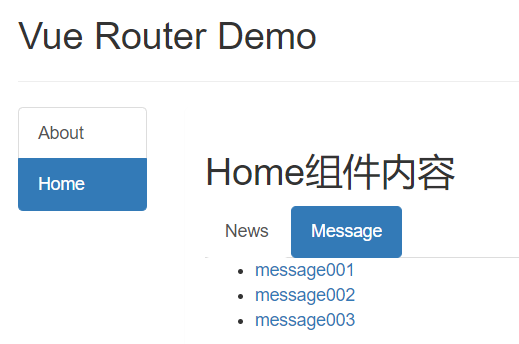
在Home的组建中又建立了路由指向了News与Message
配置路由规则,使用children配置项:
1
2
3
4
5
6
7
8
9
10
11
12
13
14
15
16
17
18
19
20
21
| routes:[
{
path:'/about',
component:About,
},
{
path:'/home',
component:Home,
children:[
{
path:'news',
component:News
},
{
path:'message',
component:Message
}
]
}
]
|
跳转(要写完整路径):<router-link to="/home/news">News</router-link>
路由的query参数
src/router.index.js:
1
2
3
4
5
6
7
8
9
10
11
12
13
14
15
16
17
18
19
20
21
22
23
24
25
26
27
28
29
30
31
32
33
34
35
36
37
38
39
40
|
import VueRouter from "vue-router";
import Home from '../pages/Home'
import About from '../pages/About'
import News from '../pages/News'
import Message from '../pages/Message'
import Detail from '../pages/Detail'
export default new VueRouter({
routes:[
{
path:'/about',
component:About
},
{
path:'/home',
component:Home,
children:[
{
path:'news',
component:News
},
{
path:'message',
component:Message,
children:[
{
path:'detail',
component:Detail
}
]
}
]
}
]
})
|
src/pages/Detail.vue:
1
2
3
4
5
6
7
8
9
10
11
12
13
| <template>
<ul>
<li>消息编号:{{$route.query.id}}</li>
<li>消息标题:{{$route.query.title}}</li>
</ul>
</template>
<script>
export default {
name:'Detail'
}
</script>
|
src/pages/Message.vue:
1
2
3
4
5
6
7
8
9
10
11
12
13
14
15
16
17
18
19
20
21
22
23
24
25
26
27
28
29
30
31
32
33
34
35
36
37
38
39
40
| <template>
<div>
<ul>
<li v-for="m in messageList" :key="m.id">
<!-- 跳转路由并携带query参数,to的字符串写法 -->
<!-- <router-link :to="`/home/message/detail?id=${m.id}&title=${m.title}`">
{{m.title}}
</router-link> -->
<!-- 跳转路由并携带query参数,to的对象写法 -->
<router-link :to="{
path:'/home/message/detail',
query:{
id:m.id,
title:m.title
}
}">
{{m.title}}
</router-link>
</li>
</ul>
<hr/>
<router-view></router-view>
</div>
</template>
<script>
export default {
name:'News',
data(){
return{
messageList:[
{id:'001',title:'消息001'},
{id:'002',title:'消息002'},
{id:'003',title:'消息003'}
]
}
}
}
</script>
|
总结:
传递参数:
1
2
3
4
5
6
7
8
9
10
11
12
| <!-- 跳转并携带query参数,to的字符串写法 -->
<router-link :to="/home/message/detail?id=666&title=你好">跳转</router-link>
<!-- 跳转并携带query参数,to的对象写法 -->
<router-link :to="{
path:'/home/message/detail',
query:{
id:666,
title:'你好'
}
}">跳转</router-link>
|
接收参数:
1
2
| $route.query.id
$route.query.title
|
路由命名
命名路由:
作用:可以简化路由的跳转
如何使用:
给路由命名:
1
2
3
4
5
6
7
8
9
10
11
12
13
14
15
16
17
18
| {
path:'/demo',
component:Demo,
children:[
{
path:'test',
component:Test,
children:[
{
name:'hello'
path:'welcome',
component:Hello,
}
]
}
]
}
|
简化跳转:
1
2
3
4
5
6
7
8
9
10
11
12
13
14
15
16
| <!--简化前,需要写完整的路径 -->
<router-link to="/demo/test/welcome">跳转</router-link>
<!--简化后,直接通过名字跳转 -->
<router-link :to="{name:'hello'}">跳转</router-link>
<!--简化写法配合传递参数 -->
<router-link
:to="{
name:'hello',
query:{
id:666,
title:'你好'
}
}"
>跳转</router-link>
|
路由的parames参数
src/router/index.js:
1
2
3
4
5
6
7
8
9
10
11
12
13
14
15
16
17
18
19
20
21
22
23
24
25
26
27
28
29
30
31
32
33
34
35
36
37
38
39
40
41
|
import VueRouter from "vue-router";
import Home from '../pages/Home'
import About from '../pages/About'
import News from '../pages/News'
import Message from '../pages/Message'
import Detail from '../pages/Detail'
export default new VueRouter({
routes:[
{
path:'/about',
component:About
},
{
path:'/home',
component:Home,
children:[
{
path:'news',
component:News
},
{
path:'message',
component:Message,
children:[
{
name:'xiangqing',
path:'detail/:id/:title',
component:Detail
}
]
}
]
}
]
})
|
src/pages/Message.vue:
1
2
3
4
5
6
7
8
9
10
11
12
13
14
15
16
17
18
19
20
21
22
23
24
25
26
27
28
29
30
31
32
33
34
35
36
37
38
39
40
41
| <template>
<div>
<ul>
<li v-for="m in messageList" :key="m.id">
<!-- 跳转路由并携带params参数,to的字符串写法 -->
<!-- <router-link :to="`/home/message/detail/${m.id}/${m.title}`">
{{m.title}}
</router-link> -->
<!-- 跳转路由并携带params参数,to的对象写法 -->
<router-link :to="{
name:'xiangqing',
params:{
id:m.id,
title:m.title
}
}">
{{m.title}}
</router-link>
</li>
</ul>
<hr/>
<router-view></router-view>
</div>
</template>
<script>
export default {
name:'News',
data(){
return{
messageList:[
{id:'001',title:'消息001'},
{id:'002',title:'消息002'},
{id:'003',title:'消息003'}
]
}
}
}
</script>
|
src/pages/Detail.vue:
1
2
3
4
5
6
7
8
9
10
11
12
13
| <template>
<ul>
<li>消息编号:{{$route.params.id}}</li>
<li>消息标题:{{$route.params.title}}</li>
</ul>
</template>
<script>
export default {
name:'Detail'
}
</script>
|
总结:
配置路由,声明接收params参数:
1
2
3
4
5
6
7
8
9
10
11
12
13
14
15
16
17
18
19
20
21
| {
path:'/home',
component:Home,
children:[
{
path:'news',
component:News
},
{
component:Message,
children:[
{
name:'xiangqing',
path:'detail/:id/:title',
component:Detail
}
]
}
]
}
|
传递参数:
1
2
3
4
5
6
7
8
9
10
11
12
13
14
| <!-- 跳转并携带params参数,to的字符串写法 -->
<router-link :to="/home/message/detail/666/你好">跳转</router-link>
<!-- 跳转并携带params参数,to的对象写法 -->
<router-link
:to="{
name:'xiangqing',
params:{
id:666,
title:'你好'
}
}"
>跳转</router-link>
|
特别注意:路由携带params参数时,若使用to的对象写法,则不能使用path配置项,必须使用name配置!
接收参数:
1
2
| $route.params.id
$route.params.title
|
params传递参
注:使用params传参只能使用name进行引入
1
2
3
4
5
6
7
8
9
10
11
12
13
14
15
16
17
18
19
20
|
this.$router.push({
name:'second',
params: {
id:'20180822',
name: 'query'
}
})
this.id = this.$route.params.id ;
this.name = this.$route.params.name ;
{
path: '/second/:id/:name',
name: 'second',
component: () => import('@/view/second')
}
|
querys与parames区别
- 传参可以使用params和query两种方式。
- 使用params传参只能用name来引入路由,即
:to里面只能是name:’xxxx’,不能是path:’/xxx’,因为params只能用name来引入路由,如果这里写成了path,接收参数页面会是undefined!!!。
- 使用query传参使用path来引入路由。
- params是路由的一部分,必须要在路由后面添加参数名。query是拼接在url后面的参数,没有也没关系。
- 二者还有点区别,直白的来说query相当于get请求,页面跳转的时候,可以在地址栏看到请求参数,而params相当于post请求,参数不会再地址栏中显示。
路由的props配置
src/pages/Message.vue:
1
2
3
4
5
6
7
8
9
10
11
12
13
14
15
16
17
18
19
20
21
22
23
24
25
26
27
28
29
30
31
32
33
34
35
| <template>
<div>
<ul>
<li v-for="m in messageList" :key="m.id">
<router-link :to="{
name:'xiangqing',
params:{
id:m.id,
title:m.title
}
}">
{{m.title}}
</router-link>
</li>
</ul>
<hr/>
<router-view></router-view>
</div>
</template>
<script>
export default {
name:'News',
data(){
return{
messageList:[
{id:'001',title:'消息001'},
{id:'002',title:'消息002'},
{id:'003',title:'消息003'}
]
}
}
}
</script>
|
src/router/index.js:
1
2
3
4
5
6
7
8
9
10
11
12
13
14
15
16
17
18
19
20
21
22
23
24
25
26
27
28
29
30
31
32
33
34
35
36
37
38
39
40
41
42
43
44
45
46
47
48
49
50
51
52
53
54
|
import VueRouter from "vue-router";
import Home from '../pages/Home'
import About from '../pages/About'
import News from '../pages/News'
import Message from '../pages/Message'
import Detail from '../pages/Detail'
export default new VueRouter({
routes:[
{
path:'/about',
component:About
},
{
path:'/home',
component:Home,
children:[
{
path:'news',
component:News
},
{
path:'message',
component:Message,
children:[
{
name:'xiangqing',
path:'detail/:id/:title',
component:Detail,
props($route){
return {
id:$route.params.id,
title:$route.params.title,
}
}
}
]
}
]
}
]
})
|
src/pages/Detail.vue:
1
2
3
4
5
6
7
8
9
10
11
12
13
14
| <template>
<ul>
<li>消息编号:{{id}}</li>
<li>消息标题:{{title}}</li>
</ul>
</template>
<script>
export default {
name:'Detail',
props:['id','title']
}
</script>
|
总结:
作用:让路由组件更方便的收到参数
1
2
3
4
5
6
7
8
9
10
11
12
13
14
15
16
17
| {
name:'xiangqing',
path:'detail/:id',
component:Detail,
props(route){
return {
id:route.query.id,
title:route.qu
}
|
路由跳转的replace方法
src/pages/Home.vue:
1
2
3
4
5
6
7
8
9
10
11
12
13
14
15
16
17
18
19
20
21
22
| <template>
<div>
<h2>Home组件内容</h2>
<div>
<ul class="nav nav-tabs">
<li>
<router-link replace class="list-group-item" active-class="active" to="/home/news">News</router-link>
</li>
<li>
<router-link replace class="list-group-item" active-class="active" to="/home/message">Message</router-link>
</li>
</ul>
<router-view></router-view>
</div>
</div>
</template>
<script>
export default {
name:'Home'
}
</script>
|
总结:
- 作用:控制路由跳转时操作浏览器历史记录的模式
- 浏览器的历史记录有两种写入方式:
push和replace,其中push是追加历史记录,replace是替换当前记录。路由跳转时候默认为push方式.使用replace方式不能使用回退返回上一界面
- 开启
replace模式:<router-link replace ...>News</router-link>
编程式路由导航
src/components/Banner.vue:
1
2
3
4
5
6
7
8
9
10
11
12
13
14
15
16
17
18
19
20
21
22
23
24
25
26
27
28
| <template>
<div class="col-xs-offset-2 col-xs-8">
<div class="page-header">
<h2>Vue Router Demo</h2>
<button @click="back">后退</button>
<button @click="forward">前进</button>
<button @click="test">测试一下go</button>
</div>
</div>
</template>
<script>
export default {
name:'Banner',
methods:{
back(){
this.$router.back()
},
forward(){
this.$router.forward()
},
test(){
this.$router.go(3)
}
},
}
</script>
|
src/pages/Message.vue:
1
2
3
4
5
6
7
8
9
10
11
12
13
14
15
16
17
18
19
20
21
22
23
24
25
26
27
28
29
30
31
32
33
34
35
36
37
38
39
40
41
42
43
44
45
46
47
48
49
50
51
52
53
54
55
56
57
| <template>
<div>
<ul>
<li v-for="m in messageList" :key="m.id">
<router-link :to="{
name:'xiangqing',
params:{
id:m.id,
title:m.title
}
}">
{{m.title}}
</router-link>
<button @click="showPush(m)">push查看</button>
<button @click="showReplace(m)">replace查看</button>
</li>
</ul>
<hr/>
<router-view></router-view>
</div>
</template>
<script>
export default {
name:'News',
data(){
return{
messageList:[
{id:'001',title:'消息001'},
{id:'002',title:'消息002'},
{id:'003',title:'消息003'}
]
}
},
methods:{
showPush(m){
this.$router.push({
name:'xiangqing',
query:{
id:m.id,
title:m.title
}
})
},
showReplace(m){
this.$router.replace({
name:'xiangqing',
query:{
id:m.id,
title:m.title
}
})
}
}
}
</script>
|
src/router/index.js:
1
2
3
4
5
6
7
8
9
10
11
12
13
14
15
16
17
18
19
20
21
22
23
24
25
26
27
28
29
30
31
32
33
34
35
36
37
38
39
40
41
42
43
44
45
46
|
import VueRouter from "vue-router";
import Home from '../pages/Home'
import About from '../pages/About'
import News from '../pages/News'
import Message from '../pages/Message'
import Detail from '../pages/Detail'
export default new VueRouter({
routes:[
{
path:'/about',
component:About
},
{
path:'/home',
component:Home,
children:[
{
path:'news',
component:News
},
{
path:'message',
component:Message,
children:[
{
name:'xiangqing',
path:'detail',
component:Detail,
props($route){
return {
id:$route.query.id,
title:$route.query.title,
}
}
}
]
}
]
}
]
})
|
src/pages/Detail.vue:
1
2
3
4
5
6
7
8
9
10
11
12
13
14
| <template>
<ul>
<li>消息编号:{{id}}</li>
<li>消息标题:{{title}}</li>
</ul>
</template>
<script>
export default {
name:'Detail',
props:['id','title']
}
</script>
|
效果:
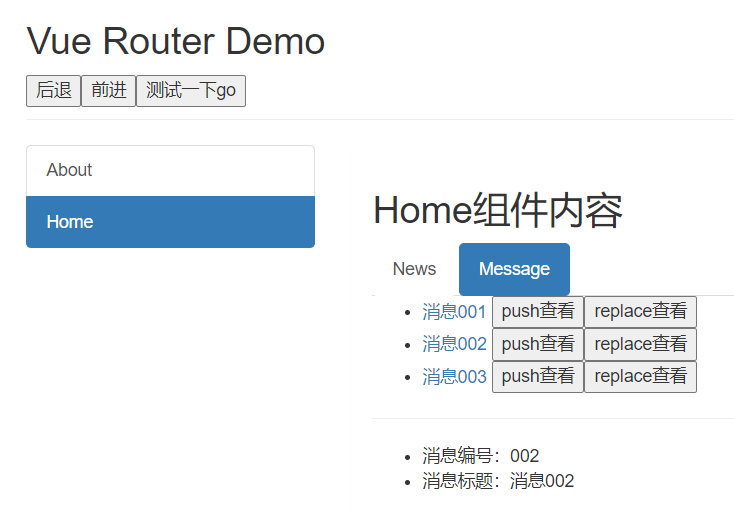
总结:
作用:不借助<router-link>实现路由跳转,让路由跳转更加灵活
具体编码:
1
2
3
4
5
6
7
8
9
10
11
12
13
14
15
16
17
18
| this.$router.push({
name:'xiangqing',
params:{
id:xxx,
title:xxx
}
})
this.$router.replace({
name:'xiangqing',
params:{
id:xxx,
title:xxx
}
})
this.$router.forward()
this.$router.back()
this.$router.go()
|
this.$router.go(val) 介绍:
在history记录中前进或者后退val步,
1
2
3
4
5
6
7
8
| - 当val为-1时回到上一页。
- 当val为0时刷新当前页面。
- 当val为1到下一页。
this.$router.go(1)
this.$router.go(-1)
|
this.$router.push(path) 介绍:
1
2
3
| - 跳转到指定URL,向history栈添加一个新的记录;
- 点击后退会返回至上一个页面
|
举例:
1
2
3
4
5
| this.$router.push('/index')
this.$router.push({path:'/index'})
this.$router.push({path:'/index',query:{name: '123'}})
this.$router.push({name:'index',params:{name:'123'}})
|
this.$router.replace介绍:
跳转到指定URL,替换history栈中最后一个记录,点击后退会返回至上上一个页面
1
| this.$router.replace(path);
|
缓存路由组件
src/pages/News.vue:
1
2
3
4
5
6
7
8
9
10
11
12
13
14
| <template>
<ul>
<li>news001 <input type="text"></li>
<li>news002 <input type="text"></li>
<li>news003 <input type="text"></li>
</ul>
</template>
<script>
export default {
name:'News'
}
</script>
|
src/pages/Home.vue:
1
2
3
4
5
6
7
8
9
10
11
12
13
14
15
16
17
18
19
20
21
22
23
24
25
| <template>
<div>
<h2>Home组件内容</h2>
<div>
<ul class="nav nav-tabs">
<li>
<router-link replace class="list-group-item" active-class="active" to="/home/news">News</router-link>
</li>
<li>
<router-link replace class="list-group-item" active-class="active" to="/home/message">Message</router-link>
</li>
</ul>
<keep-alive include="News"> // include中的组件在重新打开时会保留上次的数据
<router-view></router-view>
</keep-alive>
</div>
</div>
</template>
<script>
export default {
name:'Home'
}
</script>
|
总结:
作用:让不展示的路由组件保持挂载,不被销毁
具体编码:
1
2
3
4
5
6
7
8
9
| //缓存一个路由组件
<keep-alive include="News"> //include中写想要缓存的路由组件名,不写表示全部缓存
<router-view></router-view>
</keep-alive>
//缓存多个路由组件
<keep-alive :include="['News','Message']">
<router-view></router-view>
</keep-alive>
|
activated和deactivated
1
2
3
4
5
6
7
8
9
10
11
12
13
14
15
16
17
18
19
20
21
22
23
24
25
26
27
28
29
30
31
32
| `src/pages/News.vue`:
<template>
<ul>
<li :style="{opacity}">欢迎学习vue</li>
<li>news001 <input type="text"></li>
<li>news002 <input type="text"></li>
<li>news003 <input type="text"></li>
</ul>
</template>
<script>
export default {
name:'News',
data(){
return{
opacity:1
}
},
activated(){
console.log('News组件被激活了')
this.timer = setInterval(() => {
this.opacity -= 0.01
if(this.opacity <= 0) this.opacity = 1
},16)
},
deactivated(){
console.log('News组件失活了')
clearInterval(this.timer)
}
}
</script>
|
总结:
activated和deactivated是路由组件所独有的两个钩子,用于捕获路由组件的激活状态
具体使用:
activated路由组件被激活时触发deactivated路由组件失活时触发
只有在缓存的组件上能使用这两个周期。
1
2
3
4
| <keep-alive include="Home">
<router-view name="homeIndex"></router-view>
<router-view></router-view>
</keep-alive>
|
多个router-view,在component中添加指定的key
(23条消息) Vue之多个router-view应用_router-view 多个_Radom7的博客-CSDN博客
路由守卫
全局路由守卫
meta:路由元信息:router提供的一个容器,可以设置我们自己设置的信息。
src/router/index.js:
1
2
3
4
5
6
7
8
9
10
11
12
13
14
15
16
17
18
19
20
21
22
23
24
25
26
27
28
29
30
31
32
33
34
35
36
37
38
39
40
41
42
43
44
45
46
47
48
49
50
51
52
53
54
55
56
57
58
59
60
61
62
63
64
65
66
67
68
69
70
71
72
73
74
75
76
77
78
79
|
import VueRouter from "vue-router";
import Home from '../pages/Home'
import About from '../pages/About'
import News from '../pages/News'
import Message from '../pages/Message'
import Detail from '../pages/Detail'
const router = new VueRouter({
routes:[
{
name:'guanyv',
path:'/about',
component:About,
meta:{title:'关于'}
},
{
name:'zhuye',
path:'/home',
component:Home,
meta:{title:'主页'},
children:[
{
name:'xinwen',
path:'news',
component:News,
meta:{isAuth:true,title:'新闻'}
},
{
name:'xiaoxi',
path:'message',
component:Message,
meta:{isAuth:true,title:'消息'},
children:[
{
name:'xiangqing',
path:'detail',
component:Detail,
meta:{isAuth:true,title:'详情'},
props($route){
return {
id:$route.query.id,
title:$route.query.title,
}
}
}
]
}
]
}
]
})
router.beforeEach((to,from,next) => {
console.log('前置路由守卫',to,from)
if(to.meta.isAuth){
if(localStorage.getItem('school')==='atguigu'){
next()
}else{
alert('学校名不对,无权限查看!')
}
}else{
next()
}
})
router.afterEach((to,from)=>{
console.log('后置路由守卫',to,from)
document.title = to.meta.title || '硅谷系统'
})
export default router
|
独享路由守卫
src/router/index.js:
1
2
3
4
5
6
7
8
9
10
11
12
13
14
15
16
17
18
19
20
21
22
23
24
25
26
27
28
29
30
31
32
33
34
35
36
37
38
39
40
41
42
43
44
45
46
47
48
49
50
51
52
53
54
55
56
57
58
59
60
61
62
63
64
65
66
67
68
69
70
71
72
73
74
|
import VueRouter from "vue-router";
import Home from '../pages/Home'
import About from '../pages/About'
import News from '../pages/News'
import Message from '../pages/Message'
import Detail from '../pages/Detail'
const router = new VueRouter({
routes:[
{
name:'guanyv',
path:'/about',
component:About,
meta:{title:'关于'}
},
{
name:'zhuye',
path:'/home',
component:Home,
meta:{title:'主页'},
children:[
{
name:'xinwen',
path:'news',
component:News,
meta:{title:'新闻'},
beforeEnter(to,from,next){
console.log('独享路由守卫',to,from)
if(localStorage.getItem('school') === 'atguigu'){
next()
}else{
alert('暂无权限查看')
}
}
},
{
name:'xiaoxi',
path:'message',
component:Message,
meta:{title:'消息'},
children:[
{
name:'xiangqing',
path:'detail',
component:Detail,
meta:{title:'详情'},
props($route){
return {
id:$route.query.id,
title:$route.query.title,
}
}
}
]
}
]
}
]
})
router.afterEach((to,from)=>{
console.log('后置路由守卫',to,from)
document.title = to.meta.title || '硅谷系统'
})
export default router
|
组件内路由守卫
src/pages/About.vue:
1
2
3
4
5
6
7
8
9
10
11
12
13
14
15
16
17
18
19
20
21
22
23
| <template>
<h2>我是About组件的内容</h2>
</template>
<script>
export default {
name:'About',
//通过路由规则,进入该组件时被调用
beforeRouteEnter (to, from, next) {
console.log('About--beforeRouteEnter',to,from)
if(localStorage.getItem('school')==='atguigu'){
next()
}else{
alert('学校名不对,无权限查看!')
}
},
//通过路由规则,离开该组件时被调用
beforeRouteLeave (to, from, next) {
console.log('About--beforeRouteLeave',to,from)
next()
}
}
</script>
|
总结:
作用:对路由进行权限控制
分类:全局守卫、独享守卫、组件内守卫
全局守卫:
1
2
3
4
5
6
7
8
9
10
11
12
13
14
15
16
17
18
19
20
21
22
23
24
|
router.beforeEach((to,from,next)=>{
console.log('beforeEach',to,from)
if(to.meta.isAuth){
if(localStorage.getItem('school') === 'atguigu'){
next()
}else{
alert('暂无权限查看')
}
}else{
next()
}
})
router.afterEach((to,from) => {
console.log('afterEach',to,from)
if(to.meta.title){
document.title = to.meta.title
}else{
document.title = 'vue_test'
}
})
1234567891011121314151617181920212223
|
独享守卫:
1
2
3
4
5
6
7
8
9
| beforeEnter(to,from,next){
console.log('beforeEnter',to,from)
if(localStorage.getItem('school') === 'atguigu'){
next()
}else{
alert('暂无权限查看')
}
}
12345678
|
组件内守卫:
1
2
3
4
|
beforeRouteEnter (to, from, next) {...},
beforeRouteLeave (to, from, next) {...},
|
路由的两种工作模式
对于一个url来说,什么是hash值?—— #及其后面的内容就是hash值 eg:localhost:8080/#/home
hash值不会包含在 HTTP 请求中,即:hash值不会带给服务器
hash模式:
- 地址中永远带着#号,不美观
- 若以后将地址通过第三方手机app分享,若app校验严格,则地址会被标记为不合法
- 兼容性较好
history模式:
地址干净,美观
兼容性和hash模式相比略差
应用部署上线时需要后端人员支持,解决刷新页面服务端404的问题(前端请求静态资源时会将路径识别为网络请求传给后端,后端找不到该请求路径,出现404错误)
解决方案一:使用nginx分辨是前端路由还是后端路由
使用node.js的中间件connect-history-api-fallback
1
2
3
4
| 路由的两种模式切换:
在路由的配置中添加属性:
mode:"history" //为history
mode:"hash" //为hash
|
应用打包上线:
- 使用
npm run build将编写号的Vue文件转为纯粹的html、hs、css资源放在dist文件夹下。
- 部署:
- 新建一个文件夹,使用
npm init命令初始化项目生成pakeage.json文件(它会将我们在项目开发中所要用到的包,以及项目的详细信息等记录在这个项目中)
- 使用
npm i express安装Express框架(Express 是一个简洁而灵活的 node.js Web应用框架, 提供了一系列强大特性帮助你创建各种 Web 应用,和丰富的 HTTP 工具。)
- 新建一个static文件夹,将打包好的dist文件下的内容复制好
- 新建一个服务器文件server.js
1
2
3
4
5
6
7
8
9
10
11
12
13
| const express = require('express')
const app = express()
app.use(express.static(__dirname+'/static')) // 指定静态资源
app.listen(5005,(err=>{
if(!errr) {
console.log("服务器启动成功")
}
}))
|
Vue UI组件库
常用UI组件库
移动端常用UI组件库
- Vant
- Cube UI
- Mint UI
PC端常用UI组件库
- Element UI
- IView UI
element-ui基本使用
安装 element-ui:npm i element-ui -S
src/main.js:
1
2
3
4
5
6
7
8
9
10
11
12
13
14
15
16
| import Vue from 'vue'
import App from './App.vue'
import ElementUI from 'element-ui';
import 'element-ui/lib/theme-chalk/index.css';
Vue.config.productionTip = false
Vue.use(ElementUI)
new Vue({
el:"#app",
render: h => h(App),
})
|
src/App.vue:
1
2
3
4
5
6
7
8
9
10
11
12
13
14
15
16
17
18
19
| <template>
<div>
<br>
<el-row>
<el-button icon="el-icon-search" circle></el-button>
<el-button type="primary" icon="el-icon-edit" circle></el-button>
<el-button type="success" icon="el-icon-check" circle></el-button>
<el-button type="info" icon="el-icon-message" circle></el-button>
<el-button type="warning" icon="el-icon-star-off" circle></el-button>
<el-button type="danger" icon="el-icon-delete" circle></el-button>
</el-row>
</div>
</template>
<script>
export default {
name:'App',
}
</script>
|
element-ui按需引入
安装 babel-plugin-component:npm install babel-plugin-component -D
修改 babel-config-js:
1
2
3
4
5
6
7
8
9
10
11
12
13
14
15
16
| module.exports = {
presets: [
'@vue/cli-plugin-babel/preset',
["@babel/preset-env", { "modules": false }]
],
plugins: [
[
"component",
{
"libraryName": "element-ui",
"styleLibraryName": "theme-chalk"
}
]
]
}
123456789101112131415
|
src/main.js:
1
2
3
4
5
6
7
8
9
10
11
12
13
14
15
16
17
18
19
| import Vue from 'vue'
import App from './App.vue'
import { Button,Row } from 'element-ui'
Vue.config.productionTip = false
Vue.component(Button.name, Button);
Vue.component(Row.name, Row);
new Vue({
el:"#app",
render: h => h(App),
})
|













